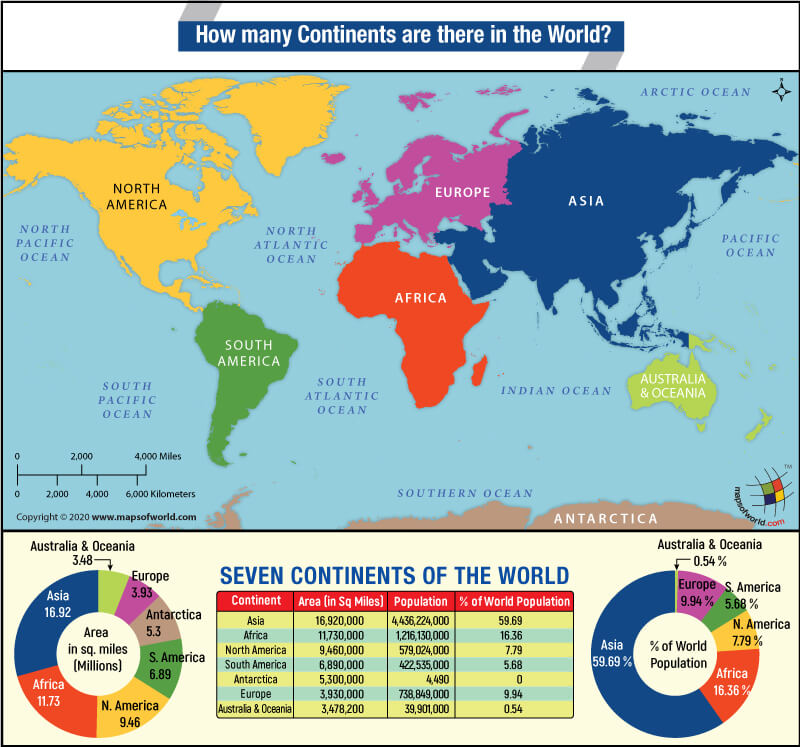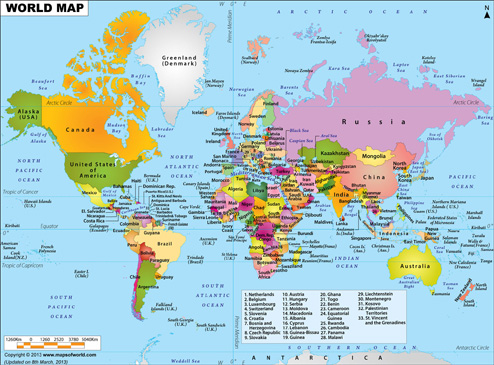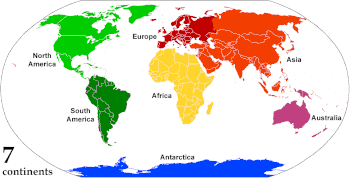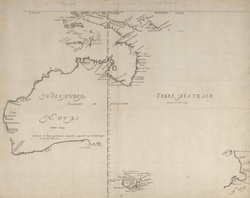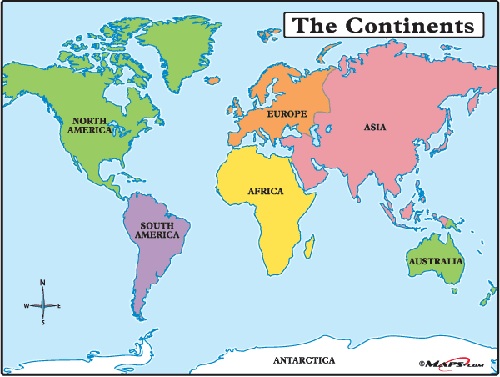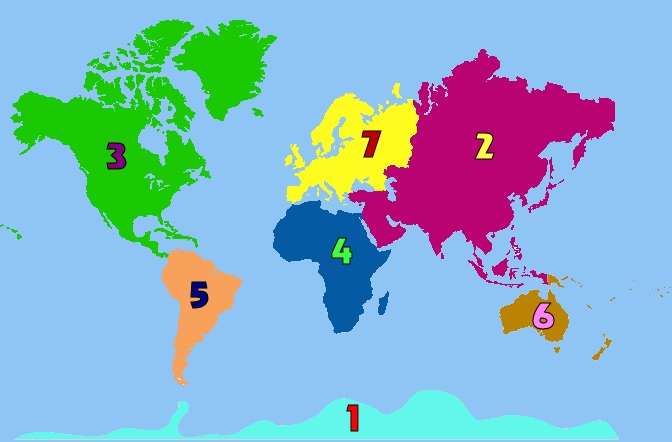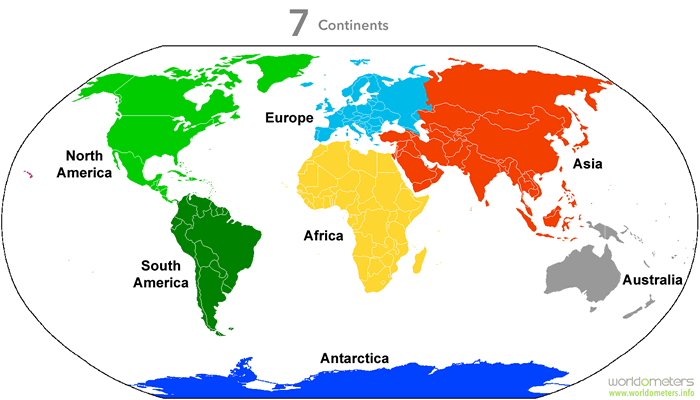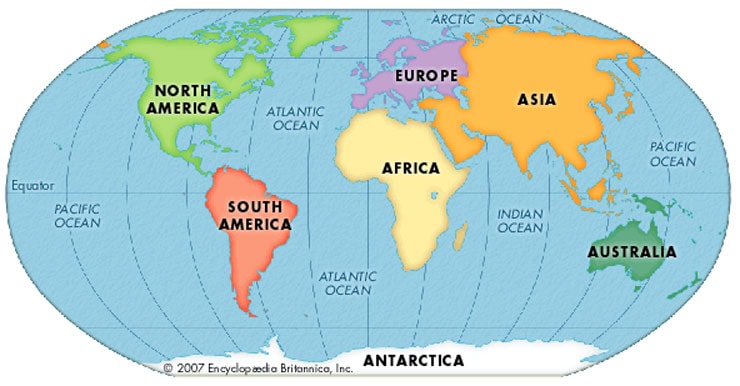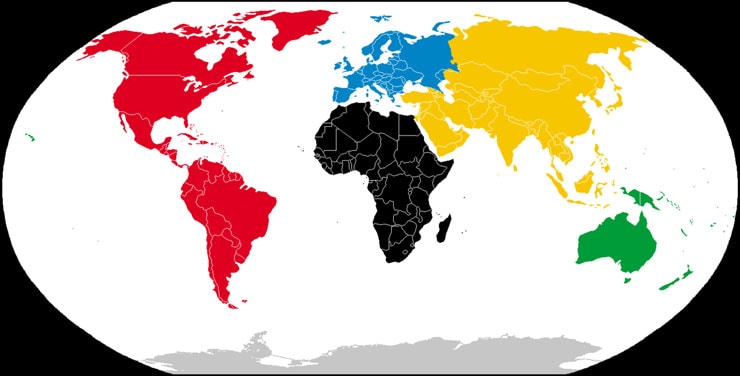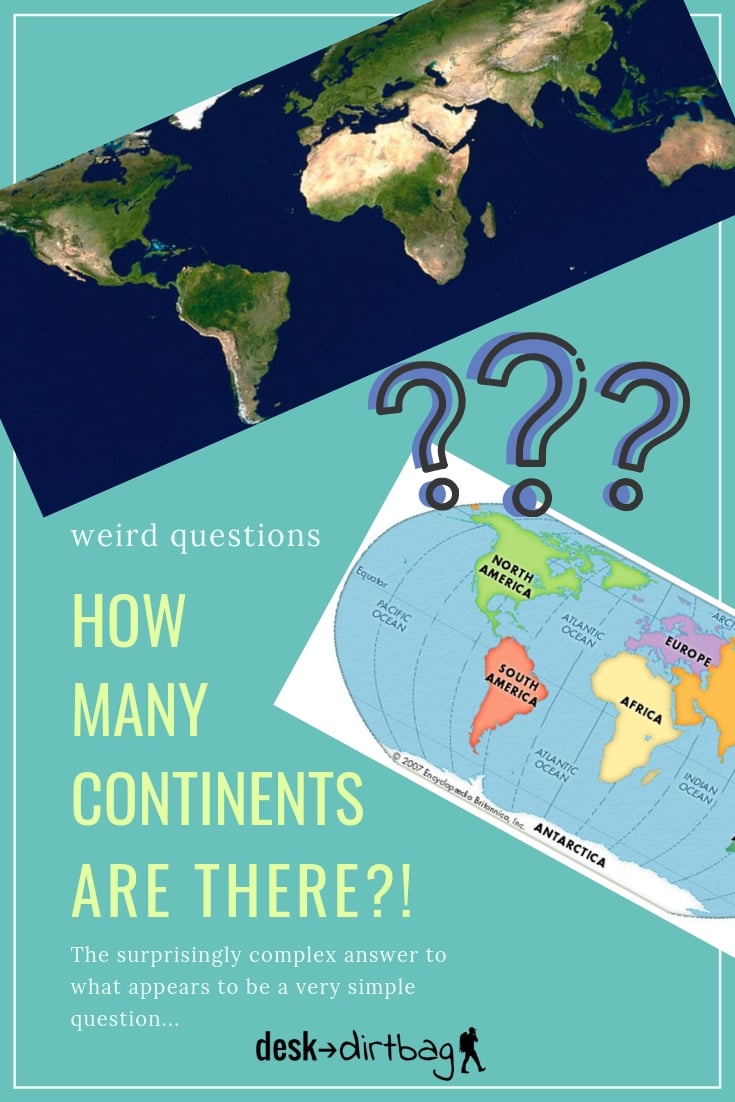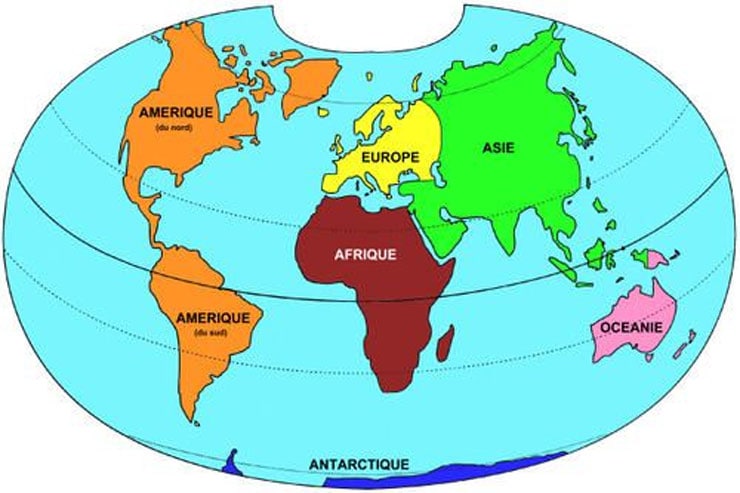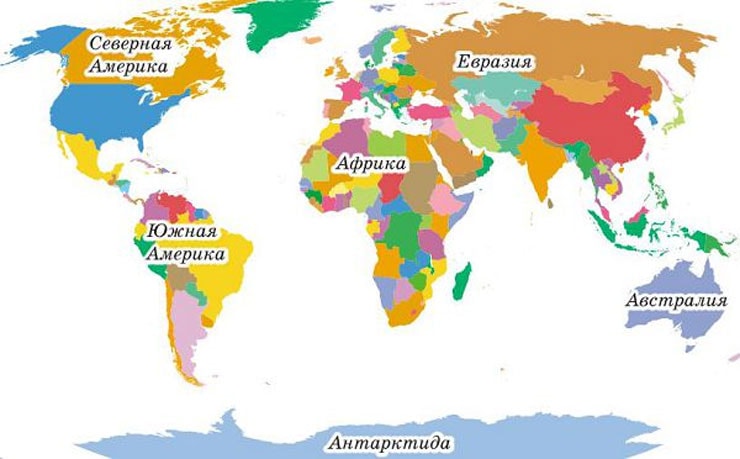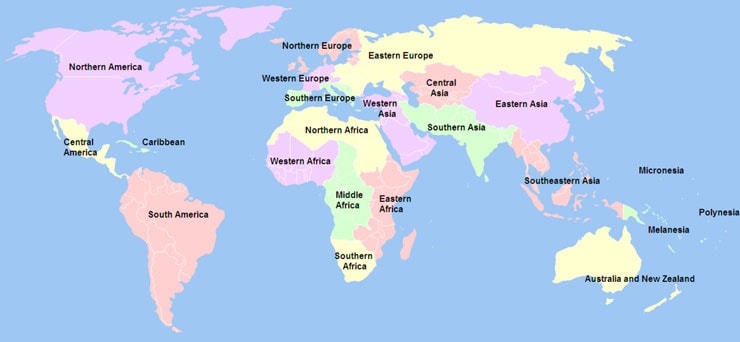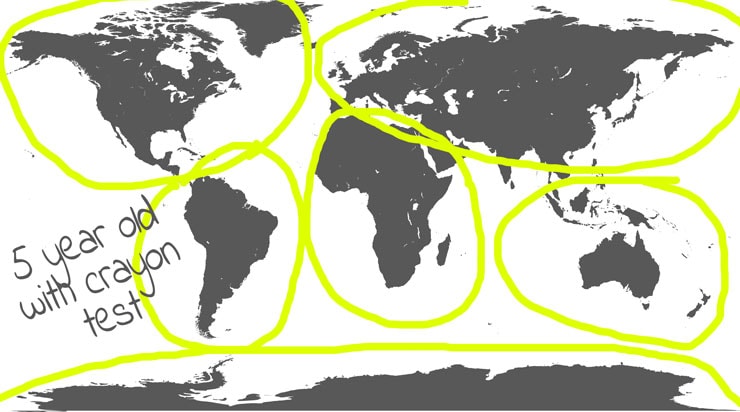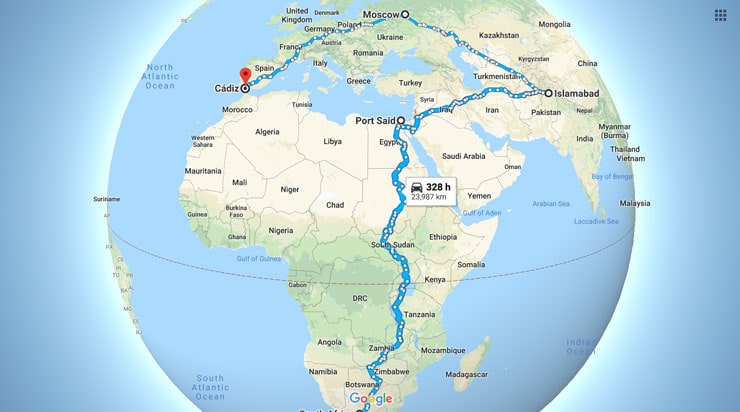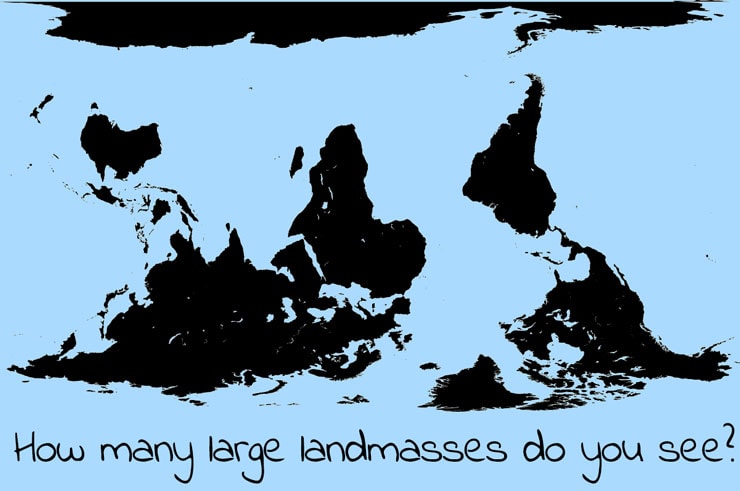There are seven continents in the world. They are; Asia, Africa, Europe, North America, South America, Antarctica, and Australia & Oceania.
A continent can be defined as a large landmass that comprises the surface of the earth. However, there is a lot of variation in the size of each of the seven continents. The continents also include the neighboring islands.
Among the seven continents, Asia is the largest in the world and covers an area of 16,920,000 square miles, which is roughly 30% of the world’s total land area. The continent comprises a population of 4,436,224,000 inhabitants, which is around 60% of the total population of the world. The continent is also home to the two most populous countries in the world – China and India.
Africa is the second-largest continent in the world and covers an area of 11,730,000 square miles. Africa is also the second most populous continent and had a population of 1,216,130,000 people as of 2016. Africa comprises around 20.4% of the total land area of the earth and is home to 54 fully sovereign recognized states. It also contains nine territories and two de facto independent states that have limited or no recognition.
North America is the third largest continent and covers an area of 9,460,000 square miles. With a population of 579,024,000 people, it is the fourth most populous continent in the world.
South America is the fourth largest continent in the world and covers an area of 6,890,000 square miles. It is the fifth most populous continent, and as of 2016 had a population of 422,535,000 people. Brazil is the largest country in South America.
The largely uninhabited Antarctica is the fifth-largest continent in the world. It comprises an area of 5,300,000 square miles. The continent does not have a permanent population, but many countries have permanently manned research stations there. The number of people conducting scientific research in Antarctica varies between 1,000 and 5,000 people. It is the driest, windiest, and coldest continent.
Europe is the sixth largest continent and the third most populous and covers an area of 3,930,000 square miles and had a population of 738,849,000, as of 2016. Russia, Turkey, and Kazakhstan are transcontinental countries with land in both Asia and Europe. The European part of Russia is the largest country in Europe.
Australia & Oceania are the smallest of the seven continents. It covers an area of 3,478,200 square miles and has a population of 39,901,000 people. New Zealand is considered to be a part of Zealandia, a submerged continent. New Zealand and Australia are both parts of Oceania.
Related Links:
- What is the Hottest Continent?
- Is Asia the Largest Continent?
- Is Egypt in Asia or Africa?
- Is America a Country or a Continent?
- What Countries Comprise Oceania?
- Is Europe a Continent?
Related Map:
Animated, colour-coded map showing the various continents. Depending on the convention and model, some continents may be consolidated or subdivided.
A continent is any of several large geographical regions. Continents are generally identified by convention rather than any strict criteria. A continent could be a single landmass or a part of a very large landmass, as in the case of Asia or Europe. Due to this, the number of continents varies; up to seven or as few as four geographical regions are commonly regarded as continents. Most English-speaking countries recognize seven regions as continents. In order from largest to smallest in area, these seven regions are Asia, Africa, North America, South America, Antarctica, Europe, and Australia.[1] Different variations with fewer continents merge some of these regions, examples of this are merging North America and South America into America, Asia and Europe into Eurasia, and Africa, Asia, and Europe into Afro-Eurasia.
Oceanic islands are frequently grouped with a nearby continent to divide all the world’s land into geographical regions. Under this scheme, most of the island countries and territories in the Pacific Ocean are grouped together with the continent of Australia to form the geographical region Oceania.[2]
In geology, a continent is defined as «one of Earth’s major landmasses, including both dry land and continental shelves».[3] The geological continents correspond to seven large areas of continental crust that are found on the tectonic plates, but exclude small continental fragments such as Madagascar that are generally referred to as microcontinents. Continental crust is only known to exist on Earth.[4]
The idea of continental drift gained recognition in the 20th century. It postulates that the current continents formed from the breaking up of a supercontinent (Pangaea) that formed hundreds of millions of years ago.
Definitions and application
By convention, continents «are understood to be large, continuous, discrete masses of land, ideally separated by expanses of water».[5] In modern schemes with five or more recognized continents, at least one pair of continents is joined by land in some fashion. The criterion «large» leads to arbitrary classification: Greenland, with a surface area of 2,166,086 square kilometres (836,330 sq mi), is only considered the world’s largest island, while Australia, at 7,617,930 square kilometres (2,941,300 sq mi), is deemed the smallest continent.
Earth’s major landmasses all have coasts on a single, continuous World Ocean, which is divided into a number of principal oceanic components by the continents and various geographic criteria.[6][7]
Extent
The most restricted meaning of continent is that of a continuous[8][non-tertiary source needed] area of land or mainland, with the coastline and any land boundaries forming the edge of the continent. In this sense, the term continental Europe (sometimes referred to in Britain as «the Continent») is used to refer to mainland Europe, excluding islands such as Great Britain, Iceland, Ireland, and Malta while the term continent of Australia may refer to the mainland of Australia, excluding New Guinea, Tasmania, and other nearby islands. Similarly, the continental United States refers to «the 49 States (including Alaska but excluding Hawaii) located on the continent of North America, and the District of Columbia.»[9]
From the perspective of geology or physical geography, continent may be extended beyond the confines of continuous dry land to include the shallow, submerged adjacent area (the continental shelf)[10] and the islands on the shelf (continental islands), as they are structurally part of the continent.[11]
From this perspective, the edge of the continental shelf is the true edge of the continent, as shorelines vary with changes in sea level.[12] In this sense the islands of Great Britain and Ireland are part of Europe, while Australia and the island of New Guinea together form a continent.
Map of island countries: these states are often grouped geographically with a neighbouring continental landmass
As a cultural construct, the concept of a continent may go beyond the continental shelf to include oceanic islands and continental fragments. In this way, Iceland is considered a part of Europe, and Madagascar a part of Africa. Extrapolating the concept to its extreme, some geographers group the Australian continental landmass with other islands in the Pacific Ocean into one «quasi-continent» called Oceania. This divides the entire land surface of Earth into continents or quasi-continents.[13]
Separation
The criterion that each continent is a discrete landmass is commonly relaxed due to historical conventions and practical use. Of the seven most globally recognized continents, only Antarctica and Australia are completely separated from other continents by the ocean. Several continents are defined not as absolutely distinct bodies but as «more or less discrete masses of land».[14] Africa and Asia are joined by the Isthmus of Suez, and North America and South America by the Isthmus of Panama. In both cases, there is no complete separation of these landmasses by water (disregarding the Suez Canal and the Panama Canal, which are both narrow and shallow, as well as man-made). Both of these isthmuses are very narrow compared to the bulk of the landmasses they unite.
North America and South America are treated as separate continents in the seven-continent model. However, they may also be viewed as a single continent known as America. This viewpoint was common in the United States until World War II, and remains prevalent in some Asian six-continent models.[15] The single American continent model remains a common view in France, Greece, Hungary, Italy, Malta, Portugal, Spain, and Latin American countries.
The criterion of a discrete landmass is completely disregarded if the continuous landmass of Eurasia is classified as two separate continents (Asia and Europe). Physiographically, Europe and the Indian subcontinent are large peninsulas of the Eurasian landmass. However, Europe is considered a continent with its comparatively large land area of 10,180,000 square kilometres (3,930,000 sq mi), while the Indian subcontinent, with less than half that area, is considered a subcontinent. The alternative view—in geology and geography—that Eurasia is a single continent results in a six-continent view of the world. Some view separation of Eurasia into Asia and Europe as a residue of Eurocentrism: «In physical, cultural and historical diversity, China and India are comparable to the entire European landmass, not to a single European country. […].»[16] However, for historical and cultural reasons, the view of Europe as a separate continent continues in almost all categorizations.
If continents are defined strictly as discrete landmasses, embracing all the contiguous land of a body, then Africa, Asia, and Europe form a single continent which may be referred to as Afro-Eurasia.[17] Combined with the consolidation of the Americas, this would produce a four-continent model consisting of Afro-Eurasia, America, Antarctica, and Australia.
When sea levels were lower during the Pleistocene ice ages, greater areas of continental shelf were exposed as dry land, forming land bridges between Tasmania and the Australian mainland.[18] At those times, Australia and New Guinea were a single, continuous continent known as Sahul. Likewise, Afro-Eurasia and the Americas were joined by the Bering Land Bridge. Other islands, such as Great Britain, were joined to the mainlands of their continents. At that time, there were just three discrete landmasses in the world: Africa-Eurasia-America, Antarctica, and Australia-New Guinea (Sahul).
Number
There are several ways of distinguishing the continents:
Color-coded map showing the various continents. Similar shades exhibit areas that may be consolidated or subdivided.
| Number | Continents | Sources | ||||||
|---|---|---|---|---|---|---|---|---|
| Four continents | Afro-Eurasia (Old World or World Island) |
America (New World) |
Antarctica | Australia | [19][17][20][21][22][23][24][25][26][27] | |||
| Five continents | Africa | Eurasia | America | Antarctica | Australia | [28][29][30][31] | ||
| Six continents | Africa | Eurasia | North America | South America | Antarctica | Australia | [32][33] | |
| Africa | Asia | Europe | America | Antarctica | Australia | [34] | ||
| Seven continents | Africa | Asia | Europe | North America | South America | Antarctica | Australia | [32][35][36][37][38][39] |
- The seven-continent model is taught in most English-speaking countries, including Australia,[40] Canada, the United Kingdom,[41] and the United States, and also in Bangladesh, China, India, Indonesia, Japan, Pakistan, the Philippines, Suriname, parts of Europe and Africa.
- The six-continent combined-Eurasia model is mostly used in Russia and some parts of Eastern Europe.
- The six-continent combined-America model is taught in some Romance-speaking countries and in Greece.[34]
- The Olympic flag’s five rings represent the five inhabited continents of the combined-America model but excludes the uninhabited Antarctica.[42]
In the English-speaking countries, geographers often use the term Oceania to denote a geographical region which includes most of the island countries and territories in the Pacific Ocean, as well as the continent of Australia.
In some non-English-speaking countries, such as China, Poland, and Russia, Oceania is considered a proper continent because their equivalent word for «continent» has a rather different meaning which can be interpreted as «a major division of land including islands» (leaning towards a region) rather than «land associated with a large landmass» (leaning towards a landmass).
Area and population
The following table provides areas given by Encyclopædia Britannica for each continent in accordance with the seven-continent model, including Australasia along with Melanesia, Micronesia, and Polynesia as parts of Oceania. It also provides populations of continents according to 2021 estimates by the United Nations Statistics Division based on the United Nations geoscheme, which includes all of Egypt (including the Isthmus of Suez and the Sinai Peninsula) as a part of Africa, all of Armenia, Azerbaijan, Cyprus, Georgia, Indonesia, Kazakhstan, and Turkey (including East Thrace) as parts of Asia, all of Russia (including Siberia) as a part of Europe, all of Panama and the United States (including Hawaii) as parts of North America, and all of Chile (including Easter Island) as a part of South America.
† Not usually considered a continent in the English-speaking countries.
Other divisions
Supercontinents
Reconstruction of the supercontinent Pangaea approximately 200 million years ago.
Apart from the current continents, the scope and meaning of the term continent includes past geological ones. Supercontinents, largely in evidence earlier in the geological record, are landmasses that comprise most of the world’s cratons or continental cores.[53] These have included Vaalbara, Kenorland, Columbia, Rodinia, Pannotia, and Pangaea. Over time, these supercontinents broke apart into large landmasses which formed the present continents.
Subcontinents
Certain parts of continents are recognized as subcontinents, especially the large peninsulas separated from the main continental landmass by geographical features. The most widely recognized example is the Indian subcontinent.[54] The Arabian Peninsula, the Southern Cone of South America, and Alaska in North America might be considered further examples.[54]
In many of these cases, the «subcontinents» concerned are on different tectonic plates from the rest of the continent, providing a geological justification for the terminology.[55] Greenland, generally reckoned as the world’s largest island on the northeastern periphery of the North American Plate, is sometimes referred to as a subcontinent.[56][57] This is a significant departure from the more conventional view of a subcontinent as comprising a very large peninsula on the fringe of a continent.[54]
Where the Americas are viewed as a single continent (America), it is divided into two subcontinents (North America and South America)[58][59][60] or three (Central America being the third).[61][62] When Eurasia is regarded as a single continent, Asia and Europe are treated as subcontinents.[54]
Submerged continents
Zealandia, the largest submerged landmass or continent
Some areas of continental crust are largely covered by the ocean and may be considered submerged continents. Notable examples are Zealandia, emerging from the ocean primarily in New Zealand and New Caledonia,[63][non-tertiary source needed] and the almost completely submerged Kerguelen Plateau in the southern Indian Ocean.[64]
Microcontinents
Some islands lie on sections of continental crust that have rifted and drifted apart from a main continental landmass. While not considered continents because of their relatively small size, they may be considered microcontinents. Madagascar, the largest example, is usually considered an island of Africa, but its divergent evolution has caused it to be referred to as «the eighth continent» from a biological perspective.[65]
Geological continents
Geologists use four key attributes to define a continent:[66]
- Elevation – The landmass, whether dry or submerged beneath the ocean, should be elevated above the surrounding ocean crust.
- Geology – The landmass should contain different types of rock: igneous, metamorphic, and sedimentary.
- Crustal structure – The landmass should consist of the continental crust, which is thicker and has a lower seismic velocity than the oceanic crust.
- Limits and area – The landmass should have clearly-defined boundaries and an area of more than one million square kilometres.
With the addition of Zealandia in 2017, Earth currently has seven commonly-recognized geological continents: Africa, Antarctica, Australia, Eurasia, North America, South America, and Zealandia. All seven geological continents are spatially isolated by geologic features.[67]
History of the concept
Early concepts of the Old World continents
The Ancient Greek geographer Strabo holding a globe showing Europa and Asia
The term «continent» translates the Greek word ἤπειρος, meaning «landmass, terra firma», the proper name of Epirus and later especially used for Asia (i.e. Asia Minor).[68]
The first distinction between continents was made by ancient Greek mariners who gave the names Europe and Asia to the lands on either side of the waterways of the Aegean Sea, the Dardanelles strait, the Sea of Marmara, the Bosporus strait and the Black Sea.[69] The names were first applied just to lands near the coast and only later extended to include the hinterlands.[70][71] But the division was only carried through to the end of navigable waterways and «… beyond that point the Hellenic geographers never succeeded in laying their finger on any inland feature in the physical landscape that could offer any convincing line for partitioning an indivisible Eurasia …»[69]
Ancient Greek thinkers subsequently debated whether Africa (then called Libya) should be considered part of Asia or a third part of the world. Division into three parts eventually came to predominate.[72] From the Greek viewpoint, the Aegean Sea was the center of the world; Asia lay to the east, Europe to the north and west, and Africa to the south.[73] The boundaries between the continents were not fixed. Early on, the Europe–Asia boundary was taken to run from the Black Sea along the Rioni River (known then as the Phasis) in Georgia. Later it was viewed as running from the Black Sea through Kerch Strait, the Sea of Azov and along the Don River (known then as the Tanais) in Russia.[74] The boundary between Asia and Africa was generally taken to be the Nile River. Herodotus[75] in the 5th century BC objected to the whole of Egypt being split between Asia and Africa («Libya») and took the boundary to lie along the western border of Egypt, regarding Egypt as part of Asia. He also questioned the division into three of what is really a single landmass,[76] a debate that continues nearly two and a half millennia later.
Eratosthenes, in the 3rd century BC, noted that some geographers divided the continents by rivers (the Nile and the Don), thus considering them «islands». Others divided the continents by isthmuses, calling the continents «peninsulas». These latter geographers set the border between Europe and Asia at the isthmus between the Black Sea and the Caspian Sea, and the border between Asia and Africa at the isthmus between the Red Sea and the mouth of Lake Bardawil on the Mediterranean Sea.[77]
Medieval T and O map showing the three continents as domains of the sons of Noah—Asia to Sem (Shem), Europe to Iafeth (Japheth), and Africa to Cham (Ham).
The Roman Empire did not attach a strong identity to these continental divisions. However, following the fall of the Western Roman Empire, the culture that developed in its place, linked to Latin and the Catholic church, began to associate itself with the concept of «Europe».[71] Through the Roman period and the Middle Ages, a few writers took the Isthmus of Suez as the boundary between Asia and Africa, but most writers continued to consider it the Nile or the western border of Egypt (Gibbon).[citation needed] In the Middle Ages, the world was usually portrayed on T and O maps, with the T representing the waters dividing the three continents. By the middle of the 18th century, «the fashion of dividing Asia and Africa at the Nile, or at the Great Catabathmus [the boundary between Egypt and Libya] farther west, had even then scarcely passed away».[78]
European arrival in the Americas
Christopher Columbus sailed across the Atlantic Ocean to the Caribbean in 1492, sparking a period of European exploration of the Americas. But despite four voyages to the Americas, Columbus never believed he had reached a new continent—he always thought it was part of Asia.
In 1501, Amerigo Vespucci and Gonçalo Coelho attempted to sail around what they considered the southern end of the Asian mainland into the Indian Ocean, passing through Fernando de Noronha. After reaching the coast of Brazil, they sailed along the coast of South America much farther south than Asia was known to extend, confirming that this was a land of continental proportions.[79] On return to Europe, an account of the voyage, called Mundus Novus («New World»), was published under Vespucci’s name in 1502 or 1503,[80] although it seems that it had additions or alterations by another writer.[81] Regardless of who penned the words, Mundus Novus credited Vespucci with saying, «I have discovered a continent in those southern regions that is inhabited by more numerous people and animals than our Europe, or Asia or Africa»,[82] the first known explicit identification of part of the Americas as a continent like the other three.
Within a few years, the name «New World» began appearing as a name for South America on world maps, such as the Oliveriana (Pesaro) map of around 1504–1505. Maps of this time, though, still showed North America connected to Asia and showed South America as a separate land.[81]
Universalis Cosmographia, Waldseemüller’s 1507 world map—the first to show the Americas separate from Asia
In 1507 Martin Waldseemüller published a world map, Universalis Cosmographia, which was the first to show North and South America as separate from Asia and surrounded by water. A small inset map above the main map explicitly showed for the first time the Americas being east of Asia and separated from Asia by an ocean, as opposed to just placing the Americas on the left end of the map and Asia on the right end. In the accompanying book Cosmographiae Introductio, Waldseemüller noted that the earth is divided into four parts, Europe, Asia, Africa, and the fourth part, which he named «America» after Amerigo Vespucci’s first name.[83] On the map, the word «America» was placed on part of South America.
The word continent
From the 16th century the English noun continent was derived from the term continent land, meaning continuous or connected land[84] and translated from the Latin terra continens.[85] The noun was used to mean «a connected or continuous tract of land» or mainland.[84] It was not applied only to very large areas of land—in the 17th century, references were made to the continents (or mainlands) of Isle of Man, Ireland and Wales and in 1745 to Sumatra.[84] The word continent was used in translating Greek and Latin writings about the three «parts» of the world, although in the original languages no word of exactly the same meaning as continent was used.[86]
While continent was used on the one hand for relatively small areas of continuous land, on the other hand geographers again raised Herodotus’s query about why a single large landmass should be divided into separate continents. In the mid-17th century, Peter Heylin wrote in his Cosmographie that «A Continent is a great quantity of Land, not separated by any Sea from the rest of the World, as the whole Continent of Europe, Asia, Africa.» In 1727, Ephraim Chambers wrote in his Cyclopædia, «The world is ordinarily divided into two grand continents: the old and the new.» And in his 1752 atlas, Emanuel Bowen defined a continent as «a large space of dry land comprehending many countries all joined together, without any separation by water. Thus Europe, Asia, and Africa is one great continent, as America is another.»[87] However, the old idea of Europe, Asia and Africa as «parts» of the world ultimately persisted with these being regarded as separate continents.
Beyond four continents
From the late 18th century, some geographers started to regard North America and South America as two parts of the world, making five parts in total. Overall though, the fourfold division prevailed well into the 19th century.[88]
Europeans discovered Australia in 1606, but for some time it was taken as part of Asia. By the late 18th century, some geographers considered it a continent in its own right, making it the sixth (or fifth for those still taking America as a single continent).[88] In 1813, Samuel Butler wrote of Australia as «New Holland, an immense island, which some geographers dignify with the appellation of another continent» and the Oxford English Dictionary was just as equivocal some decades later.[89] It was in the 1950s that the concept of Oceania as a «great division» of the world was replaced by the concept of Australia as a continent.[90]
Antarctica was sighted in 1820 during the First Russian Antarctic Expedition and described as a continent by Charles Wilkes on the United States Exploring Expedition in 1838, the last continent identified, although a great «Antarctic» (antipodean) landmass had been anticipated for millennia. An 1849 atlas labelled Antarctica as a continent but few atlases did so until after World War II.[91]
Over time, the western concept of dividing the world into continents spread globally, replacing conceptions in other areas of the world. The idea of continents continued to become imbued with cultural and political meaning. In the 19th century during the Meiji period, Japanese leaders began to self-identify with the concept of being Asian, and renew relations with other «Asian» countries while conceiving of the idea of Asian solidarity against western countries. This conception of an Asian identity, as well as the idea of Asian solidarity, was later taken up by others in the region, such as Republican China and Vietnam.[92]
From the mid-19th century, atlases published in the United States more commonly treated North and South America as separate continents, while atlases published in Europe usually considered them one continent. However, it was still not uncommon for American atlases to treat them as one continent up until World War II.[93] From the 1950s, most U.S. geographers divided the Americas into two continents.[93] With the addition of Antarctica, this made the seven-continent model. However, this division of the Americas never appealed to Latin Americans, who saw their region spanning an América as a single landmass, and there the conception of six continents remains dominant, as it does in scattered other countries.[citation needed]
Some geographers regard Europe and Asia together as a single continent, dubbed Eurasia.[94] In this model, the world is divided into six continents, with North America and South America considered separate continents.
Geology
Geologists use the term continent in a different manner from geographers. In geology, a continent is defined by continental crust, which is a platform of metamorphic and igneous rock, largely of granitic composition. Continental crust is less dense and much thicker than oceanic crust, which causes it to «float» higher than oceanic crust on the dense underlying mantle. This explains why the continents form high platforms surrounded by deep ocean basins.[95][3]
Some geologists restrict the term continent to portions of the crust built around stable regions called cratons. Cratons have largely been unaffected by mountain-building events (orogenies) since the Precambrian. A craton typically consists of a continental shield surrounded by a continental platform. The shield is a region where ancient crystalline basement rock (typically 1.5 to 3.8 billion years old) is widely exposed at the surface. The platform surrounding the shield is also composed of ancient basement rock, but with a cover of younger sedimentary rock.[96] The continents are accretionary crustal «rafts» that, unlike the denser basaltic crust of the ocean basins, are not subjected to destruction through the plate tectonic process of subduction. This accounts for the great age of the rocks comprising the continental cratons.[97]
The margins of geologic continents are either active or passive. An active margin is characterised by mountain building, either through a continent-on continent collision or a subduction zone. Continents grow by accreting lighter volcanic island chains and microcontinents along these active margins, forming orogens. At a passive margin, the continental crust is stretched thin by extension to form a continental shelf, which tapers off with a gradual slope covered in sediment, connecting it directly to the oceanic crust beyond. Most passive margins eventually transition into active margins: where the oceanic plate becomes too heavy due to cooling, it disconnects from the continental crust, and starts subducting below it, forming a new subduction zone.[98]
Principal tectonic plates of the continents and the floor of the oceans
There are many microcontinents, or continental fragments, that are built of continental crust but do not contain a craton. Some of these are fragments of Gondwana or other ancient cratonic continents: Zealandia,[99] which includes New Zealand and New Caledonia; Madagascar; the northern Mascarene Plateau, which includes the Seychelles. Other islands, such as several in the Caribbean Sea, are composed largely of granitic rock as well, but all continents contain both granitic and basaltic crust, and there is no clear boundary as to which islands would be considered microcontinents under such a definition. The Kerguelen Plateau, for example, is largely volcanic, but is associated with the breakup of Gondwanaland and is considered a microcontinent,[100][101] whereas volcanic Iceland and Hawaii are not. The British Isles, Sri Lanka, Borneo, and Newfoundland were on the margins of the Laurasian continent—only separated from the main continental landmass by inland seas flooding its margins.
The movement of plates has caused the continual formation and breakup of continents, and occasionally supercontinents, in a process called the Wilson Cycle. The supercontinent Columbia or Nuna formed during a period of 2.0–1.8 billion years ago and broke up about 1.5–1.3 billion years ago.[102][103] The supercontinent Rodinia is thought to have formed about 1 billion years ago and to have embodied most or all of Earth’s continents, and broken up into eight continents around 600 million years ago. The eight continents later reassembled into another supercontinent called Pangaea; Pangaea broke up into Laurasia (which became North America and Eurasia) and Gondwana (which became the remaining continents).[104]
See also
- Boundaries between the continents of Earth
- Dvipa
- Forgotten continent
- List of continent name etymologies
- List of continents and continental subregions by population
- List of sovereign states and dependent territories by continent
- List of transcontinental countries
- Lists of cities
- Mainland Australia
- Subregion
References
- ^ «Continents: What is a Continent?». National Geographic. 20 September 2011. «Most people recognize seven continents—Asia, Africa, North America, South America, Antarctica, Europe, and Australia, from largest to smallest—although sometimes Asia and Europe are considered a single continent, Eurasia.»
- ^ Murray, Warwick E. (2016). «Changing Rural Worlds – A Global View». In Daniels, Peter; Bradshaw, Michael; Shaw, Denis; Sidaway, James; Hall, Tim (eds.). An Introduction To Human Geography (5th ed.). Pearson. p. 231. ISBN 978-1-292-12939-6.
- ^ a b Neuendorf, K.K.E.; Mehl, J.P. Jr.; Jackson, J.A., eds. (2005). Glossary of Geology (5th ed.). Alexandria, Virginia: American Geological Institute. p. 139. ISBN 978-0922152896.
- ^ Choi, Charles Q. (16 July 2015). «Did Ancient Mars Have Continents?». Space.com. Retrieved 6 December 2020.
- ^ Lewis & Wigen, The Myth of Continents (1997), p. 21.
- ^ «Ocean». answers.com. 2006. Archived from the original on 3 March 2007. Retrieved 20 February 2007.
- ^ «Distribution of land and water on the planet Archived 31 May 2008 at the Wayback Machine.» UN Atlas of the Oceans Archived 15 September 2008 at the Wayback Machine (2004). Retrieved 20 February 2007.
- ^ «continent n. 5. a.» (1989) Oxford English Dictionary, 2nd edition. Oxford University Press; «continent1 n.» (2006) The Concise Oxford English Dictionary, 11th edition revised. (Ed.) Catherine Soanes and Angus Stevenson. Oxford University Press; «continent1 n.» (2005) The New Oxford American Dictionary, 2nd edition. (Ed.) Erin McKean. Oxford University Press; «continent [2, n] 4 a» (1996) Webster’s Third New International Dictionary, Unabridged. ProQuest Information and Learning; «continent» (2007) Encyclopædia Britannica. Retrieved 14 January 2007, from Encyclopædia Britannica Online.
- ^ «What constitutes the United States, what are the official definitions?». www.usgs.gov. Retrieved 21 November 2022.
- ^ «continent [2, n] 6» (1996) Webster’s Third New International Dictionary, Unabridged. ProQuest Information and Learning. «a large segment of the earth’s outer shell including a terrestrial continent and the adjacent continental shelf»
- ^ Monkhouse, F. J.; Small, John (1978). A Dictionary of the Natural Environment. London: Edward Arnold. pp. 67–68.
structurally it includes shallowly submerged adjacent areas (continental shelf) and neighbouring islands
- ^ Ollier, Cliff D. (1996). Planet Earth. In Ian Douglas (Ed.), Companion Encyclopedia of Geography: The Environment and Humankind. London: Routledge, p. 30. «Ocean waters extend onto continental rocks at continental shelves, and the true edges of the continents are the steeper continental slopes. The actual shorelines are rather accidental, depending on the height of sea-level on the sloping shelves.»
- ^ Lewis & Wigen, The Myth of Continents (1997), p. 40: «The joining of Australia with various Pacific islands to form the quasi continent of Oceania … «
- ^ Lewis & Wigen, The Myth of Continents (1997), p. 35.
- ^ Lewis & Wigen, The Myth of Continents (1997), Chapter 1: «While it might seem surprising to find North and South America still joined into a single continent in a book published in the United States in 1937, such a notion remained fairly common until World War II. […] By the 1950s, however, virtually all American geographers had come to insist that the visually distinct landmasses of North and South America deserved separate designations.»
- ^ Lewis & Wigen, The Myth of Continents (1997), pp. 104–123.
- ^ a b McColl, R.W., ed. (2005). «continents». Encyclopedia of World Geography. Vol. 1. Facts on File, Inc. p. 215. ISBN 978-0-8160-7229-3. Retrieved 26 June 2012 – via Google Books.
And since Africa and Asia are connected at the Suez Peninsula, Europe, Africa, and Asia are sometimes combined as Afro-Eurasia or Eurafrasia. The International Olympic Committee’s official flag, containing […] the single continent of America (North and South America being connected as the Isthmus of Panama).
- ^ Chopping, Richard; Blewett, Richard; Kennett, Brian (2018). The Australian Continent. Canberra: Australia National University Press. p. 4. doi:10.22459/ac.08.2018. ISBN 978-1-76046-247-5. S2CID 135195553.
- ^ Dempsey, Caitlin (15 October 2013). «Geography Facts about the World’s Continents». Geography Realm. Retrieved 26 August 2022.
- ^ [1] «4 Continents
This would probably be the correct subdivision if we adopted a strict definition of continents, ideally defined as large landmasses separated by water. Furthermore, we should consider «separated» only what is naturally separated, excluding therefore the separations resulting from the artificially made Panama Canal (which separates North and South America) and Suez Canal (which separates Africa from Eurasia).Under this model, the four continents of the world are: Afro-Eurasia (or Eurafrasia), America, Antarctica, and Australia (not Oceania, which combines Australia with smaller countries in the Pacific Ocean which are separated by water).
An alternative four-continent model, introduced at the beginning of the 20th century, included Europe, Asia, Africa, and America.»worldometers
- ^ «How many continents are there?». Wonderopolis.
If you count Europe and Asia as one continent (called Eurasia), then there are six continents. Some people also count North America and South America as one continent (called America), since the two land masses are separated only by the human-made Panama Canal. This would allow for a model with only five continents.
wonderopolis - ^ Strobel, Christoph (11 February 2015). The Global Atlantic: 1400 to 1900. Routledge. pp. 13–. ISBN 978-1-317-52552-3.
- ^ Manual of Modern Geography: 2. William Blackwood. 1870. pp. 18– – via Google Books.
- ^ Dunn, Ross E.; Mitchell, Laura J.; Ward, Kerry (23 August 2016). The New World History: A Field Guide for Teachers and Researchers. University of California Press. pp. 232–. ISBN 978-0-520-28989-5 – via Google Books.
- ^ Chatterjee, Sankar (13 March 2015). The Rise of Birds: 225 Million Years of Evolution. Johns Hopkins University Press. pp. 204–. ISBN 978-1-4214-1614-4 – via Google Books.
- ^ Mackay, Alexander (1861). Manual of Modern Geography: Mathematical, Physical, and Political : on a New Plan : Embracing a Complete Development of the River Systems of the Globe. W. Blackwood and Sons. pp. 15–.
- ^ Kermack, D. M. (9 March 2013). The Evolution of Mammalian Characters. Springer Science+Business Media. pp. 141–. ISBN 978-1-4684-7817-4 – via Google Books.
- ^ [2] «In some textbooks, North and South America are combined into «America» and/or Europe and Asia are combined into «Eurasia», for a grant total of 6 or even 5.»scienceline
- ^ Martin W. Lewis and Kären E. Wigen, The Myth of Continents: A Critique of Metageography (Berkeley and Los Angeles: University of California Press, 1997)Wigen
- ^ [3] «5 Continents
This model adopts the criteria of both the six-continent models, resulting in the following 5 continents: Africa, Eurasia, America, Oceania (or Australia), and Antarctica.An alternative five-continent model is the one adopted, among others, by the Olympic Charter, which excludes Antarctica as uninhabited and lists the following five: Africa, Europe, Asia, America, and Oceania (or Australia).»worldometers2
- ^ [4] «There are even geographical views that prefer the presence of both a Eurasian as well as one American continent. These geographers therefore contend that there should only be 5 continents.»universetoday
- ^ a b «Continent». Encyclopædia Britannica. 2006. Chicago: Encyclopædia Britannica, Inc.
- ^ «Continent». The Columbia Encyclopedia. New York: Columbia University Press. 2001. Archived from the original on 2 February 2007 – via Bartleby.
- ^ a b [5] Older/previous official Greek Paedagogical Institute 6th grade Geography textbook (at the Wayback Machine), 5+1 continents combined-America model; Pankosmios Enyklopaidikos Atlas, CIL Hellas Publications, ISBN 84-407-0470-4, p. 30, 5+1 combined-America continents model; Neos Eikonographemenos Geographikos Atlas, Siola-Alexiou, 6 continents combined-America model; Lexico tes Hellenikes Glossas, Papyros Publications, ISBN 978-960-6715-47-1, lemma continent (epeiros), 5 continents model; Lexico Triantaphyllide online dictionary, Greek Language Center (Kentro Hellenikes Glossas), lemma continent (epeiros), 6 continents combined-America model; Lexico tes Neas Hellenikes Glossas, G.Babiniotes, Kentro Lexikologias (Legicology Center) LTD Publications, ISBN 960-86190-1-7, lemma continent (epeiros), 6 continents combined-America model
- ^ World, National Geographic — Xpeditions Atlas. 2006. Washington, DC: National Geographic Society.
- ^ The World — Continents Archived 21 February 2006 at the Wayback Machine, Atlas of Canada
- ^ The New Oxford Dictionary of English. 2001. New York: Oxford University Press.
- ^ «Continent Archived 28 October 2009 at the Wayback Machine». MSN Encarta Online Encyclopedia 2006.. 31 October 2009.
- ^ «Continent». McArthur, Tom, ed. 1992. The Oxford Companion to the English Language. New York: Oxford University Press; p. 260.
- ^ «F-10 Curriculum Geograph». Australian Curriculum, Assessment, and Reporting Authority. Archived from the original on 24 March 2014.
- ^ «National curriculum in England: geography programmes of study». UK Department for Education.
- ^ «Preamble» (PDF). Olympic Charter. International Olympic Committee. 17 July 2020. p. 10. Retrieved 3 August 2021.
the five interlaced rings, which represent the union of the five continents
- ^ «Asia». Encyclopædia Britannica. 16 November 2020. Retrieved 20 July 2021.
- ^ «Africa». Encyclopædia Britannica. 30 October 2020. Retrieved 20 July 2021.
- ^ «North America». Encyclopædia Britannica. 12 February 2021. Retrieved 20 July 2021.
- ^ «South America». Encyclopædia Britannica. 7 February 2021. Retrieved 20 July 2021.
- ^ «Antarctica». Encyclopædia Britannica. 10 March 2021. Retrieved 20 July 2021.
- ^ «Europe». Encyclopædia Britannica. 26 November 2020. Retrieved 20 July 2021.
- ^ «Australia». Encyclopædia Britannica. 19 July 2021. Retrieved 20 July 2021.
- ^ «Oceania». Encyclopædia Britannica. 30 January 2020. Retrieved 20 July 2021.
- ^ «World Population Prospects 2022». population.un.org. United Nations Department of Economic and Social Affairs, Population Division. Retrieved 17 July 2022.
- ^ «World Population Prospects 2022: Demographic indicators by region, subregion and country, annually for 1950-2100» (XSLX). population.un.org («Total Population, as of 1 July (thousands)»). United Nations Department of Economic and Social Affairs, Population Division. Retrieved 17 July 2022.
- ^ Evans, D.A.D. (2013). «Reconstructing pre-Pangean supercontinents» (PDF). GSA Bulletin. 125 (11–12): 1736. Bibcode:2013GSAB..125.1735E. doi:10.1130/B30950.1.
- ^ a b c d Baldwin, James A. (2014), «Continents», in R.W. McColl (ed.), Encyclopedia of World Geography, Infobase Publishing, pp. 214–216, ISBN 978-0-8160-7229-3 – via Google Books
- ^ Molnar, Peter (2015). Plate Tectonics: A Very Short Introduction. Oxford: Oxford University Press. ISBN 978-0-19-104396-3 – via Google Books.
- p. 98: Thus, we can calculate past positions of the Indian Plate, with the Indian Subcontinent as its passenger, with respect to the Eurasian Plate.
- p. 116: The Arabian Subcontinent later, approximately 35 million years ago, collided with southern Eurasia to form the Zagros Mountains of southwestern Iran.
- ^ Nares Strait and the drift of Greenland: a conflict in plate tectonics. Museum Tusculanum Press. 1982. pp. 32–. ISBN 978-87-635-1150-6 – via Google Books.
- ^ Farmer, G. Thomas; Cook, John (2013), Climate Change Science: A Modern Synthesis: Volume 1 — The Physical Climate, Springer Science+Business Media, pp. 281–, ISBN 978-94-007-5757-8 – via Google Books
- ^ Gallay, Alan (2015). Colonial Wars of North America, 1512–1763 (Routledge Revivals): An Encyclopedia. Routledge. pp. 204–. ISBN 978-1-317-48719-7 – via Google Books.
- ^ Innes, John L.; Haron, Abu Hassan (2000). Air Pollution and the Forests of Developing and Rapidly Industrializing Regions. CABI. pp. 36–. ISBN 978-0-85199-932-6 – via Google Books.
- ^ Vivares, Ernesto (2014). Exploring the New South American Regionalism (NSAR). Ashgate Publishing, Ltd. pp. 40–. ISBN 978-1-4094-6961-2 – via Google Books.
- ^ Leonard, Thomas M. (2005). Encyclopedia of the Developing World. Psychology Press. pp. 1637–. ISBN 978-1-57958-388-0 – via Google Books.
- ^ In Ibero-America, North America usually designates a region (subcontinente in Spanish) of the Americas containing Canada, the United States, and Mexico, and often Greenland, Saint Pierre and Miquelon, and Bermuda; the land bridge of Central America is generally considered a subregion of North America.Norteamérica (Mexican version) Archived 30 January 2009 at the Wayback Machine/(Spaniard version) Archived 29 January 2009 at the Wayback Machine. Encarta Online Encyclopedia.. 31 October 2009.
- ^ Rafferty, John P. «A Tale of Two Submerged Continents». Encyclopedia Britannica. Retrieved 26 December 2020.
- ^ Cassimaly, Khalil a (5 March 2013). «The Violent History Of Mauritia: Birth, Oblivion, Renaissance | Labcoat Life | Learn Science at Scitable». Nature. Retrieved 31 December 2020.
- ^ Hillstrom, Kevin; Collier Hillstrom, Laurie (2003). Africa and the Middle East: a continental overview of environmental issues. Santa Barbara, CA: ABC-CLIO. p. 50. ISBN 978-1-57607-688-0 – via Google Books.
- ^ GSA Today – Zealandia: Earth’s Hidden Continent
- ^ Big Think – Earth’s Hidden Continent Zealandia Finally Recognized
- ^ Henry George Liddell, Robert Scott, Henry Stuart Jones, A Greek-English Lexicon (1940), s.v. ἤπειρος. The English noun was introduced in the mid-16th century, shortened from continent land (15th century), adapted from Latin terra continens «continuous landmass».
- ^ a b Toynbee, Arnold J. (1954). A Study of History. London: Oxford University Press, v. 8, pp. 711–712.
- ^ Tozer, H. F. (1897). A History of Ancient Geography. Cambridge: University Press. p. 69.
- ^ a b Pocock, J. G. A. (2002). «Some Europes in Their History». In Pagden, Anthony (ed.). The Idea of Europe From Antiquity to the European Union. Cambridge University Press. pp. 57–61. doi:10.1017/CBO9780511496813.003. ISBN 9780511496813.
- ^ Tozer, H. F. (1897). A History of Ancient Geography. Cambridge: Cambridge University Press. p. 67.
- ^ Lewis & Wigen, The Myth of Continents (1997), pp. 21–22.
- ^ Tozer, H. F. (1897). A History of Ancient Geography. Cambridge: Cambridge University Press. p. 68.
- ^ Herodotus. Translated by George Rawlinson (2000). The Histories of Herodotus of Halicarnassus. [6] Ames, Iowa: Omphaloskepsis, book 2, p. 18. Archived 19 August 2006 at the Wayback Machine
- ^ Herodotus. Translated by George Rawlinson (2000). The Histories of Herodotus of Halicarnassus «Archived copy» (PDF). Archived from the original (PDF) on 19 August 2006. Retrieved 8 February 2016.
{{cite web}}: CS1 maint: archived copy as title (link). Ames, Iowa: Omphaloskepsis, book 4, p. 38. «I cannot conceive why three names … should ever have been given to a tract which is in reality one,» - ^ Strabo. Translated by Horace Leonard Jones (1917). Geography.[7] Harvard University Press, book 1, ch. 4.[8]
- ^ Goddard, Farley Brewer (1884). «Researches in the Cyrenaica». The American Journal of Philology, 5 (1) p. 38.
- ^ O’Gorman, Edmundo (1961). The Invention of America. Indiana University Press. pp. 106–112.
- ^ Formisano, Luciano (Ed.) (1992). Letters from a New World: Amerigo Vespucci’s Discovery of America. New York: Marsilio, pp. xx–xxi. ISBN 0-941419-62-2.
- ^ a b Zerubavel, Eviatar (2003). Terra Cognita: The Mental Discovery of America. New Brunswick: Transaction Publishers, pp. 77–79. ISBN 0-7658-0987-7.
- ^ Formisano, Luciano (Ed.) (1992). Letters from a New World: Amerigo Vespucci’s Discovery of America. New York: Marsilio, p. 45. ISBN 0-941419-62-2.
- ^ Zerubavel, Eviatar (2003). Terra Cognita: The Mental Discovery of America. New Brunswick: Transaction Publishers, pp. 80–82. ISBN 0-7658-0987-7.
- ^ a b c «continent n.» (1989) Oxford English Dictionary, 2nd edition. Oxford University Press.
- ^ «continent1 n.» (2006) The Concise Oxford English Dictionary, 11th edition revised. (Ed.) Catherine Soanes and Angus Stevenson. Oxford University Press.
- ^ Lewis & Wigen, The Myth of Continents (1997), p. 29.
- ^ Bowen, Emanuel. (1752). A Complete Atlas, or Distinct View of the Known World. London, p. 3.
- ^ a b Lewis & Wigen, The Myth of Continents (1997), p. 30
- ^ «continent n. 5. a.» (1989) Oxford English Dictionary, 2nd edition. Oxford University Press. «the great island of Australia is sometimes reckoned as another [continent]»
- ^ Lewis & Wigen, The Myth of Continents (1997), p. 32: «…the 1950s… was also the period when… Oceania as a «great division» was replaced by Australia as a continent along with a series of isolated and continentally attached islands. [Footnote 78: When Southeast Asia was conceptualized as a world region during World War II…, Indonesia and the Philippines were perforce added to Asia, which reduced the extent of Oceania, leading to a reconceptualization of Australia as a continent in its own right. This maneuver is apparent in postwar atlases]»
- ^ Lewis, Martin W.; Wigen, Kären E. (1997). The Myth of Continents: a Critique of Metageography. Berkeley: University of California Press. ISBN 978-0-520-20743-1.
- ^ Mitani, Hiroshi (Fall 2006). «The Concept of Asia: From Geography to Ideology». New Perspectives on Turkey. 35: 21–34. doi:10.1017/S0896634600004465. S2CID 130570425.
- ^ a b Lewis, Martin W.; Wigen, Kären E. (1997). The Myth of Continents: a Critique of Metageography. Berkeley: University of California Press. p. 32. ISBN 978-0-520-20742-4.
- ^ Some geographers list only six continents, combining Europe and Asia into Eurasia. In parts of the world, students learn that there are just five continents: Eurasia, Australia, Africa, Antarctica, and the Americas.«How many continents are there?». National Geographic Society. Retrieved 26 September 2010.
- ^ Levin, Harold L. (2010). The earth through time (9th ed.). Hoboken, N.J.: J. Wiley. pp. 173–174. ISBN 9780470387740.
- ^ Levin 2010, p. 83.
- ^ Levin 2010, p. 194.
- ^ Grotzinger, John P. (2014). «10». Understanding Earth. Thomas H. Jordan (7t ed.). New York. ISBN 978-1-4641-3874-4. OCLC 884299180.
- ^ Mortimer, N.; Campbell, H.J.; Tulloch, A.J.; King, P.R.; Stagpoole, V.M.; Wood, R.A.; Rattenbury, M.S.; Sutherland, R.; Adams, C.J.; Collot, J.; Seton, M. (2017). «Zealandia: Earth’s Hidden Continent». GSA Today. 27 (3): 27–35. doi:10.1130/GSATG321A.1.
- ^ «UT Austin scientist plays major rule in study of underwater «micro-continent»«. Utexas.edu. Archived from the original on 3 November 2007. Retrieved 26 August 2012.
- ^ «Sci/Tech | ‘Lost continent’ discovered». BBC News. 27 May 1999. Retrieved 26 August 2012.
- ^ Zhao, Guochun; Cawood, Peter A.; Wilde, Simon A.; Sun, M. (November 2002). «Review of global 2.1–1.8 Ga orogens: implications for a pre-Rodinia supercontinent». Earth-Science Reviews. 59 (1): 125–162. Bibcode:2002ESRv…59..125Z. doi:10.1016/S0012-8252(02)00073-9.
- ^ Zhao, Guochun; Sun, M.; Wilde, Simon A.; Li, S.Z. (November 2004). «A Paleo-Mesoproterozoic supercontinent: assembly, growth and breakup». Earth-Science Reviews. 67 (1): 91–123. Bibcode:2004ESRv…67…91Z. doi:10.1016/j.earscirev.2004.02.003.
- ^ Grotzinger, John P. (2014). Understanding Earth. Thomas H. Jordan (7 ed.). New York. ISBN 978-1-4641-3874-4. OCLC 884299180.
Bibliography
- Lewis, Martin W.; Wigen, Kären E. (1997). The Myth of Continents: a Critique of Metageography. Berkeley: University of California Press. ISBN 978-0-520-20743-1 – via Google Books.
External links
- Continent at the Encyclopædia Britannica
- «Continent» . Encyclopædia Britannica (11th ed.). 1911.
- «What Are Continents?» on YouTube by CGP Grey
- Lost continent revealed in new reconstruction of geologic history

There are seven 7 continents in the world. Continent means one of the principal land masses of the earth.If you count Europe and Asia continent as one continent (Eurosia) there are 6 continents.There are several number of continents as you can think.
List of continents:
1. North America
2. South America
3. Europe
4. Asia
5. Africa
6. Antarctica
7. Australia (Oceania)
Number of continents
7 continents : North America , South America , Antarctica , Africa , Europe , Asia , Australia
6 continents : North America ,South America , Antarctica , Africa ,Eurasia , Australia
6 continents : America , Antarctica , Africa , Europe , Asia , Australia
5 continents : America , Africa , Europe , Asia , Australia
5 continents : America , Antarctica , Africa , Eurasia , Australia
4 continents : America , Antarctica ,Afro-Eurasia ,Australia
Source : Wikipedia
More From How Many Are There ?
About The Author
Howmanyarethere
I am a mechanical engineer and obsessed with the numbers. I am very curious man and adventurist. And also i am working for you, don’t ask yourself ask us .
- W
- Continents
- 7 Continents
The seven-continent model is probably the most widely taught. There are however other ways of grouping countries into continents.
List of the seven continents
Ranked by current population
| # | Continent | Population (2020) |
Area (Km²) |
Density (P/Km²) |
World Population Share |
|---|---|---|---|---|---|
| 1 | Asia | 4,641,054,775 | 31,033,131 | 150 | 59.54% |
| 2 | Africa | 1,340,598,147 | 29,648,481 | 45 | 17.20% |
| 3 | Europe | 747,636,026 | 22,134,900 | 34 | 9.59% |
| 4 | North America | 592,072,212 | 21,330,000 | 28 | 7.60% |
| 5 | South America | 430,759,766 | 17,461,112 | 25 | 5.53% |
| 6 | Australia/Oceania | 43,111,704 | 8,486,460 | 5 | 0.55% |
| 7 | Antarctica | 0 | 13,720,000 | 0 | 0.00% |
Which continent does Russia belong to?
Russia is part of both Europe and Asia. In the 7 continent model in fact, it is not always clear where to place Russia. In the map pictured above Russia is divided into two parts (European Russia and the «Asian part» of the Russian Federation) along the Ural Mountains line, from the source of the Ural River down to the Greater Caucasus from the Caspian Sea to the Black Sea (following the modern definition of Europe as provided by the National Geographic Society). However, in the list of continents, we had to place Russia in one continent or the other, so we placed it in Europe, following the United Nations classification.
About 75% of the Russian population lives in the European continent. On the other hand, 75% of Russian territory is located in Asia.
Which continent does Hawaii belong to?
None. Hawaii is politically part of North America, but geographically it is not part of any continent.
A continent is typically defined as a very large landmass, surrounded on all sides (or nearly so) by water and containing a number of nation-states. However, when it comes to the number of continents on Earth, experts don’t always agree. Depending on the criteria used, there may be five, six, or seven continents. Sounds confusing, right? Here’s how it all sorts out.
Defining a Continent
The «Glossary of Geology,» which is published by the American Geosciences Institute, defines a continent as “one of the Earth’s major landmasses, including both dry land and continental shelves.» Other characteristics of a continent include:
- Areas of land that are elevated in relation to the surrounding ocean floor
- A variety of rock formations, including igneous, metamorphic, and sedimentary
- A crust that is thicker than those of the surrounding oceanic crusts. For example, the continental crust may vary in thickness from about 18 to 28 miles in depth, whereas oceanic crust is usually about 4 miles thick
- Clearly-defined boundaries
This last characteristic is the most controversial, according to the Geological Society of America, leading to confusion among experts as to how many continents there are. What’s more, there is no global governing body that has established a consensus definition.
How Many Continents Are There?
If you went to school in the United States, chances are you were taught that there are seven continents: Africa, Antarctica, Asia, Australia, Europe, North America, and South America. But using the criteria defined above, many geologists say there are six continents: Africa, Antarctica, Australia, North and South America, and Eurasia. In many parts of Europe, students are taught that there are only six continents, and teachers count North and South America as one continent.
Why the difference? From a geological perspective, Europe and Asia are one large landmass. Dividing them into two separate continents is more of a geopolitical consideration because Russia occupies so much of the Asian continent and historically has been politically isolated from the powers of Western Europe, such as Great Britain, Germany, and France.
Recently, some geologists have begun arguing that room should be made for a «new» continent called Zealandia. This landmass lies off the eastern coast of Australia. New Zealand and a few minor islands are the only peaks above water; the remaining 94 percent is submerged beneath the Pacific Ocean.
Other Ways to Count Landmasses
Geographers divide the planet into regions for ease of study. The Official Listing of Countries by Region divides the world into eight regions: Asia, the Middle East and North Africa, Europe, North America, Central America and the Caribbean, South America, Africa, and Australia and Oceania.
You can also divide the Earth’s major landmasses into tectonic plates, which are large slabs of solid rock. These slabs consist of both continental and oceanic crusts and are separated by fault lines. There are 15 tectonic plates in total, seven of which are roughly ten million square miles or more in size. Not surprisingly, these roughly correspond to the shapes of the continents that lie atop them.
Sources
- Mortimer, Nick. «Zealandia: Earth’s Hidden Continent.» Volume 27 Issue 3, The Geological Society of America, Inc., March/April 2017.
- Neuendorf, Klaus K.E. «Glossary of Geology.» James P. Mehl Jr., Julia A. Jackson, Hardcover, Fifth Edition (revised), American Geosciences Institute, November 21, 2011.
There are 7 continents in the world. Most people agree with that but there are some who say there are 6, some say 5. But there are 7. If you’ve read my article about how many countries in the world you’ll know that I’ve been lucky enough to visit all 7 continents on many different occasions on my way to visiting every country on the planet. When I planning on making this list about how many continents in the world I was going through old travel photos and remembering how special each continent is.
All 7 of them have their own special qualities, uniqueness and you should definitely visit as many of them as possible.
Table of contents
- How Many Continents In The World? 5,6,7?
- What is a Continent?
- What Are The 7 Continents?
- Africa
- Antarctica
- Asia
- Australia (or Australasia)
- Europe
- North America
- South America
- Does everyone agree with 7 Continents in the world??
- Why Do Some Say There are 5 or 6 Continents in the world?
- So to confirm, how many continents are there?

What is a Continent?
There are tons of definitions that people use to identify a continent. The most commonly used and most simple is to identify a large landmass which is separated by oceans from other large landmasses. The 7 continents that we have in the world are always changing shape because the earth’s water defines the landmass of each continent. Don’t forget that water makes up around 2/3 of the earth’s surface, so boundaries and shapes of continents are altered as the waters change. All of the 7 continents used to be connected as one landmass known as Pangea, but we’re talking millennia ago. Now we can easily recognize that there are 7 distinct continents.
What Are The 7 Continents?
It is widely accepted that the 7 continents are:
- Africa
- Antarctica
- Asia
- Australia (also known as Australasia)
- Europe
- North America
- South America
Some people can get confused about the name and mistake continents for regions, I’ll take you through each continent and clear up any confusion.
Africa
Number Of Countries: 56
Africa is the second-largest continent on the planet and is an awesome place to travel through. The last frontier of authentic travel, it may be said. Make sure you like the heat before you head there because it is home to some of the world’s hottest countries. Check out my article about how many countries are there in Africa, there are plenty of disputed territories in the region which is why my country count may surprise you.
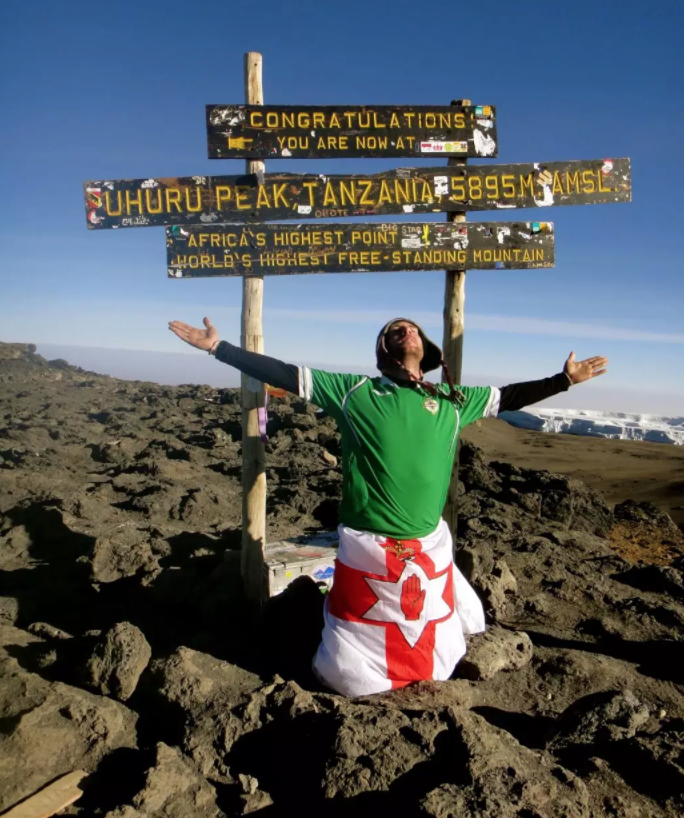
Antarctica
Number Of Countries: 0
How many countries are there in Antarctica is a pretty simple question to answer because there are none! 7 countries do lay claim to certain parts of the continent for research and scientific purposes. You may also see it referred to as either the White or Frozen continent. It’s not surprising that it’s the coldest place on earth because over 3 quarters of the earth’s ice can be found here. There are no permanent residents in Antarctica but you will find adventurous travellers. Here are some reasons why you should consider visiting Antarctica.
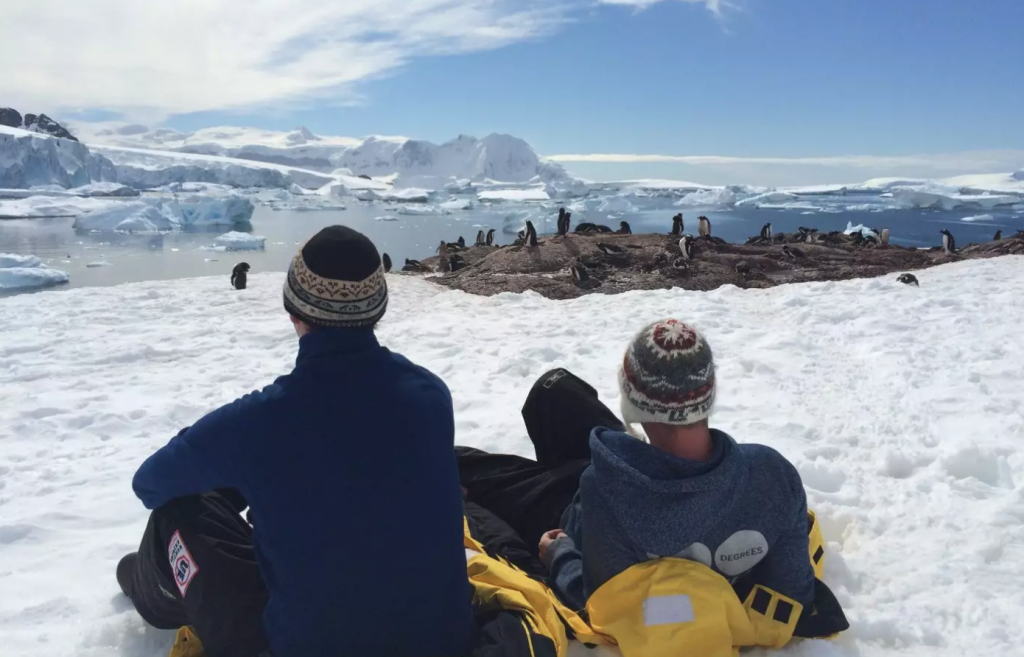
Asia
Number Of Countries: 49
My home! Asia is by far the largest continent on the planet in terms of size (9% of the planet’s surface) and population (4.3 billion, 60% of the world’s population) – with the likes of China, India and Russia located within this continent it’s always going to keep the top spot. If you want to see how many countries in Asia I think there are then check out my article. It can be a bit controversial when deciding which countries are part of Asia and Europe.

Australia (or Australasia)
Number Of Countries: 3
First things first, Australia is a continent and you can also call it Australasia. People are sometimes surprised to hear that the continent only contains 3 countries, that’s because they confuse the continent with the Oceania region. How many countries in Australia varies depends on who you talk to, there are in 14 Australia/Oceania. Check out my article to read my explanation.

Europe
Number Of Countries: 49
It was fun making my list of how many countries are there in Europe, that’s because the continent is part of the same landmass as Asia. I am sure that when you guys read my article not all of you will agree of the countries I include and those that I don’t. Home to nearly 3 quarters of a million people, including me in my Irish youth.

North America
Number Of Countries: 23
North America is a continent that also includes Central America and The Caribbean. How many countries are there in North America is a long-debated topic because some people argue that North and South America are one continent. It’s a huge area with 5 time zones and the only place on the planet with every single type of climate.
If you want to know how many countries in the Caribbean, I blogged that too.
If you want to know how many countries in Central America, I blogged that too.
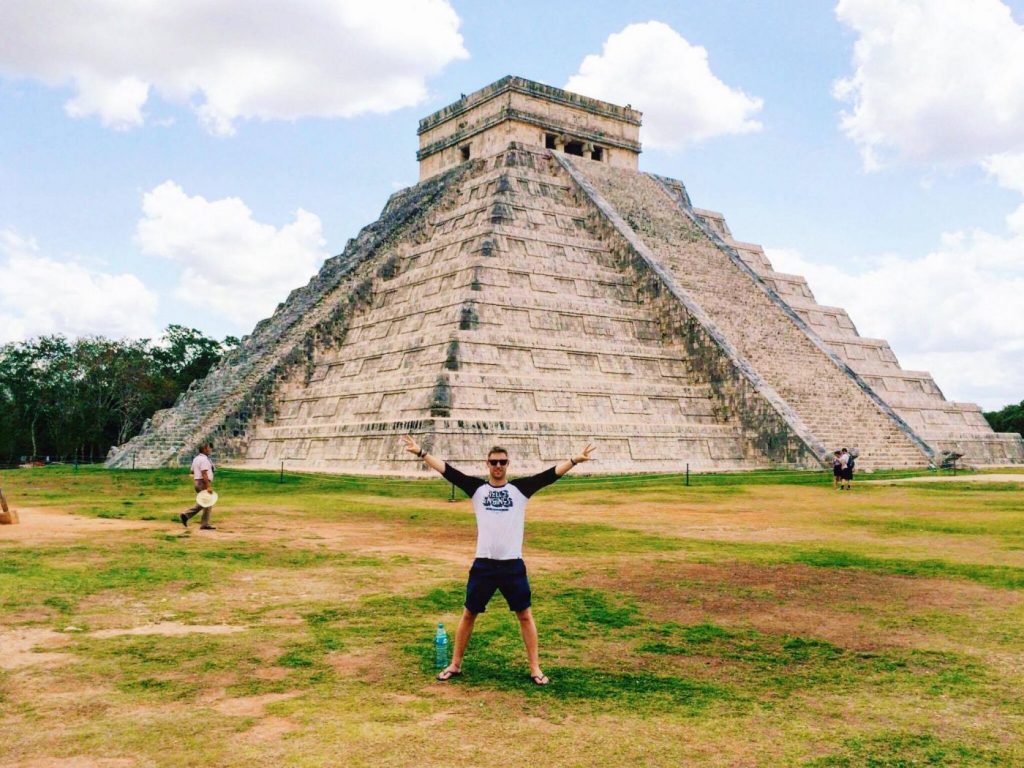
South America
Number Of Countries: 12
My article about how many countries in South America will show you the 12 countries and lesser-known dependencies which make up the continent. It’s the 4th biggest continent on the planet and an awesome place to visit because you’ll find the Himalayas (Mt. Aconcagua is there which I completed on my mission to climb all 7 peaks), the Amazon river, Angel Falls and much more.
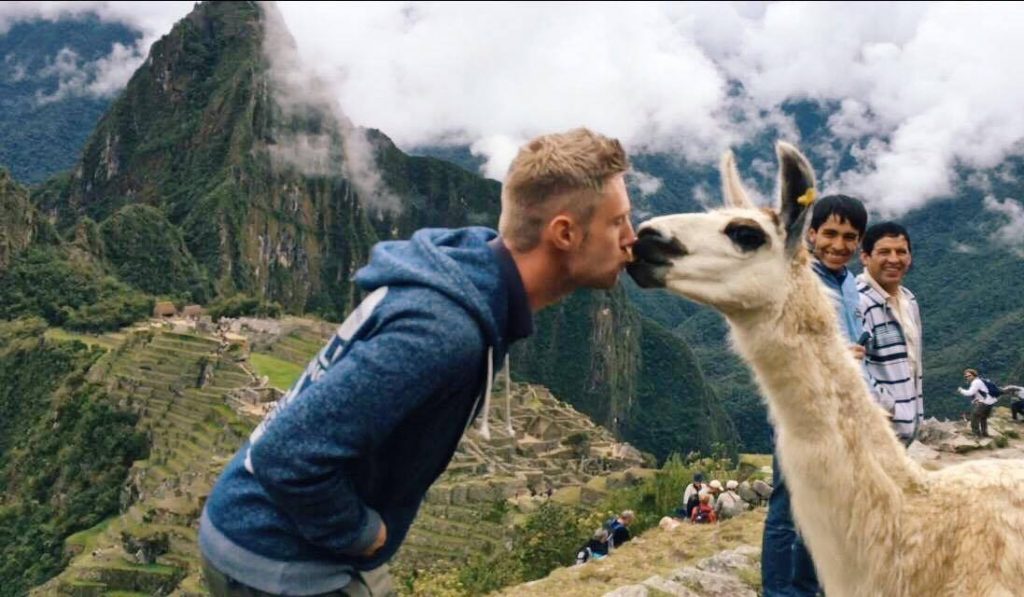
Does everyone agree with 7 Continents in the world??
Nope! Interestingly enough not everyone agrees that there are 7 continents in the world. The reason being that some people combine North and South America because it is one landmass, therefore, should be classed as one continent in their eyes, calling it the ‘American Continent.’
The other contentious issue for a few people is Europe and Asia, some people combine them into one continent calling it ‘Eurasia.’
Why Do Some Say There are 5 or 6 Continents in the world?
TLDR? So why do some people say there are 5 or 6 continents?
North and South America as 1 continent; The Americas
Because they may not separate North and South America as 2 continents, and call it one continent ‘The Americas’.
Europe and Asia as 1 continent; Eurasia
And some include Europe and Asia as 1 continent, calling it Eurasia.
Coming from Ireland, I have only ever been taught that there are 7 continents in the world. I’m pretty sure most of you reading this are the same too. That wasn’t always the case because back in the day people used to be taught that there were 5 continents; Africa, America, Asia, Australia and Europe.
Take a look at the Olympic symbol again. There are 5 rings and that’s because it used to be accepted that there were 5 continents (not separating the 2 Americas and also not including Antarctica). Some countries teach that there are 6 continents in the world; America, Antarctica, Asia, Africa, Australia and Europe (not separating the 2 Americas).
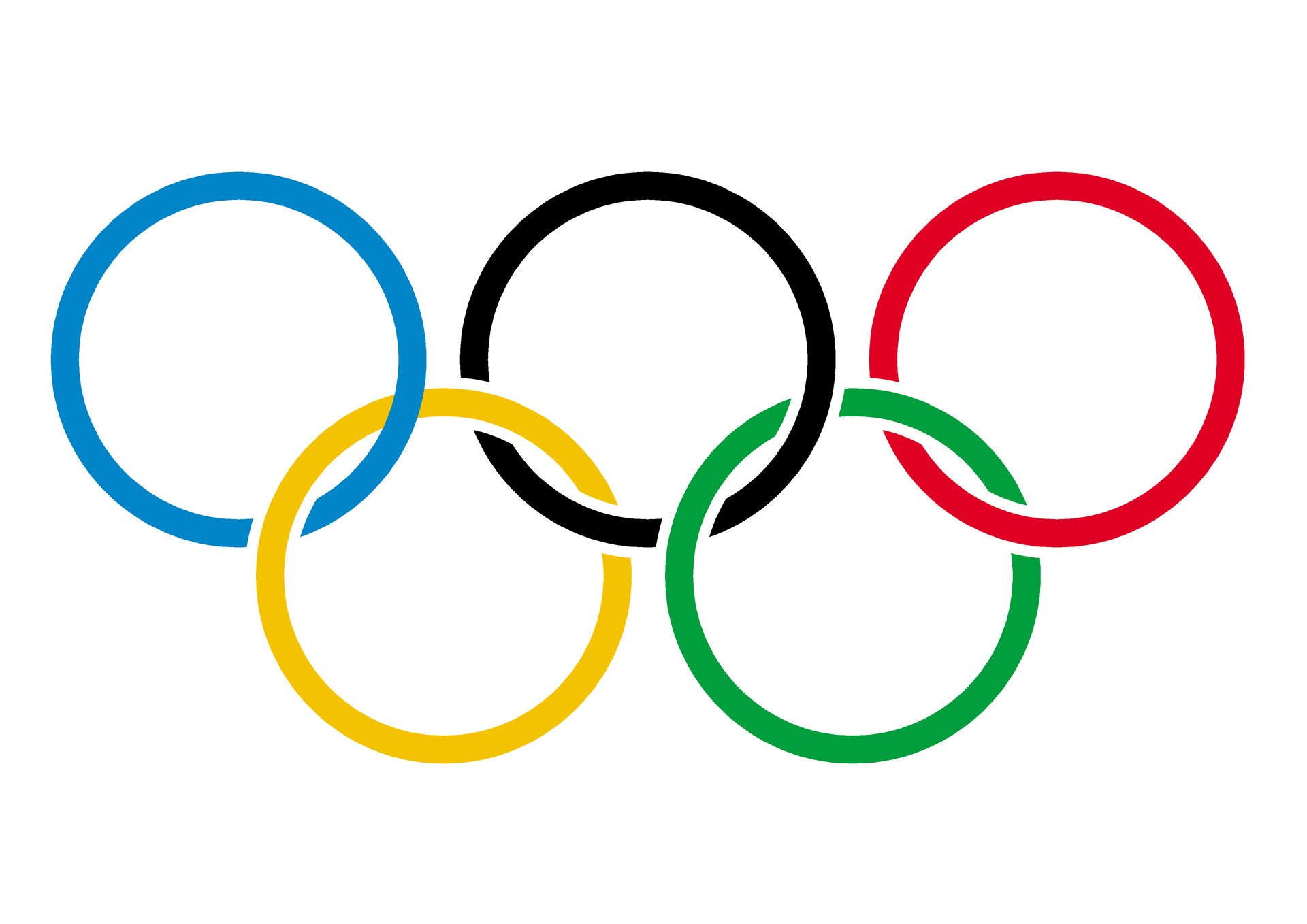
So to confirm, how many continents are there?
I understand why some say 5 and 6 but there are 7 continents in the world. Hope this helps!
Remember, never travel without travel insurance! And never overpay for travel insurance!
I use HeyMondo. You get INSTANT quotes. Super cheap, they actually pay out, AND they cover almost everywhere, where most insurance companies don’t (even places like Central African Republic etc!). You can sign-up here. PS You even get 5% off if you use MY LINK! You can even sign up if you’re already overseas and traveling, pretty cool.
Also, if you want to start a blog…I CAN HELP YOU!
Also, if you want to start a blog, and start to change your life, I’d love to help you! Email me on johnny@onestep4ward.com. In the meantime, check out my super easy blog post on how to start a travel blog in under 30 minutes, here! And if you just want to get cracking, use BlueHost at a discount, through me.
Also, (if you’re like me, and awful with tech-stuff) email me and my team can get a blog up and running for you, designed and everything, for $699 — email johnny@onestep4ward.com to get started.
Do you work remotely? Are you a digital nomad/blogger etc? You need to be insured too.
I use SafetyWing for my digital nomad insurance. It covers me while I live overseas. It’s just $10 a week, and it’s amazing! No upfront fees, you just pay week by week, and you can sign up just for a week if you want, then switch it off and on whenever. You can read my review here, and you can sign-up here!
So if you’re ready to…..
1) Change your life
2) Travel the world
3) Get paid to travel
4) Create a positive influence on others
5) Be free of offices and ‘real world’ rubbish
Then Sign Up Below and Let’s Get Started!
Some people say there are four continents, others swear that there are five, six, or seven. Who is right?
How many continents are there, really?
Fun experiment: How many continuous landmasses do you see?
(Image: Strebe/Public domain)
On paper, the question about the continents seems simple. A continent is a large landmass surrounded by water, so it is like a huge island.
Thus, if you were to pick up a world map and count the huge landmasses, you should have your answer. Right? Wrong.
Try it with the map above. This may raise more questions than it will answer: Wait, the Americas look like one continent, weren’t they supposed to be two? Europe and Asia look like one huge continent too!? Is Africa part of Asia…?
Worry not. Nobody has got a straight answer to this question. If you ask geographers, they will admit that it all comes down to convention.
They will also probably tell you that ‘continent’ is not a scientific term. So there are no strict criteria for defining a continent.
A continent does not have to have a minimum size or be a certain distance from other landmasses. Australia, for example, was for ages considered an island; only recently it got upgraded to ‘continent.’
How one divides the continents boils down more to history and culture than to undisputed scientific facts. (If you are thinking: “No way, what about the tectonic plates?” Read below)
Continental Europeans count different continents than their UK peers
If you went to school in the UK, the US, or other English-speaking countries after 1960, you were probably taught that there are 7 continents.
But if you went to school in many other European, African, Asian nations, or the rest of the Americas, you may have learned that there are 6 or 5 continents.
The purists count just 4 continents. Some slim it down even more and count 3.
While others go in the opposite direction and count more than 7.
Since there are no strict criteria for defining what a continent is, all those answers are valid. It just depends on how you are counting.
These are the models with most fans nowadays:
The choice of purists. It is way less popular than the others, though.
This is the predominant view in Eastern Europe, Asia, and elsewhere.
A classic. This model had a good run for most of the 20th century. It was taught in the Americas, Europe, and elsewhere.
Like the previous one, but with Antarctica on board. Most countries in the Americas, many in Western Europe and Africa divide the world like this. The United Nations also uses this model.
This 6-continent version may not be as diffused worldwide, but it has some die-hard fans like the Norwegians and Russians. (Russians also learn the previous model in tandem.)
The all-inclusive super-deluxe 7-continent combo. It is the version beloved in most English-speaking countries. It is also favored in some north European countries, and in some Asian countries like China and Singapore.
(Images: AlexCovarrubias and Corticopious/Public domain)
Dilemma #1: Are Europe and Asia two continents or one?
Definitely one continent. #teamEurasia (Image: Wikimedia/Public domain)
Definitely two continents. #team7continents. (Image: Harbin/Public domain)
Europe and Asia are really just one continent. Eurasia is a continuous (the word contin-ent comes from contin-uous) landmass.
But most people consider them two continents because of historical reasons.
Before 500 BC, the Greek geographers thought that Europe and Asia were separate continents. To get to Asia, the Greeks had to cross the sea. So Europe and Asia seemed like separate landmasses to them.
Advertisement
Furthermore, the European Greeks were constantly quarreling with the Persians from Asia. And each group thought the other dressed in a funny way and had strange traditions. So the divide between the two was not just physical, but also historical and cultural.
From 500 BC onwards, the Greeks realized that Africa, Asia, and Europe were one landmass and thus, one continent. But by then, the cultural division was already too deeply set, and they continued to consider them separate continents.
That mindset has trickled down to our days. Plenty of people still think of Europe and Asia as separate continents.
The countries that have territories in both Asia and Europe
Russia, Kazakhstan, Georgia, Azerbaijan, and Turkey have territories in both Europe and Asia. According to some divisions, so does Armenia. (Image: Wikimedia/Public domain)
Where exactly Asia ends and Europe begins has been a matter of controversy for hundreds of years. And there is still no agreement on where exactly is the border.
Whichever border you choose, some countries get caught in the crossfire. Russia, Kazakhstan, Azerbaijan, Turkey, Georgia, and sometimes Armenia, end up having territories in both Asia and Europe.
So you can be walking in the Asian side of Russia and all of a sudden find yourself in Europe.
Who prefers ‘Eurasia’ and who does not
Most geographers consider Eurasia one continent.
Unsurprisingly, those born near the border also call it Eurasia. That includes Eastern Europeans and Western Asians.
They prefer the term not only because of the pesky border itself, but also because they have deep historical and cultural ties with both sides.
It would even be odd if, say, Russia, with its history and location, thought of Eurasia as two continents. To Russians, both sides are home.
On the other hand, those who live far from the border get to philosophize about the division.
That is true for the countries located at the extremes of Eurasia -like Spain and China.
They are so distant, that they had zero interaction with each other for millennia. So each developed its own unique culture. And now the culture of the other seems strange.
So they readily think of Europe and Asia as different entities. And consider those on the other side of the border as foreigners. Us vs. them.
This view prevails in some Asian countries and in Western Europe. Also in places influenced by Greek thought, such as the Americas and Africa.
More on Russia: Why Is Catherine the Great of Russia called ‘Great’? Her Accomplishments
Dilemma #2: Africa
(Image: LukeSurl/CCBYSA4.0)
Up to the 18th century, and even 19th, it was usual to simplify things and say there were two continents: the Old World and the New World.
The Old World included Africa, Asia, and Europe; the New World, the Americas.
Another look at the map will show that there is sense in that.
Africa and Asia are, indeed, joined. Egypt has land in both Africa and Asia. The only separation between them is a shallow, man-made canal dug over a century ago.
So some people still consider that Africa, Europe, and Asia form one big continent called Afro-Eurasia.
Four Awesome African Kingdoms Nobody Told You About. They are ancient and from sub-Saharan Africa
Dilemma #3: America. Or is it the AmericaS?
One or two, take your pick.
After the Europeans bumped into the New World, they called it ‘America.’ And, apart from some glitches here and there, that was the continent’s name for more than 400 years.
In some maps, the continent was divided into subregions: North America, South America, and usually the West Indies/Caribbean.
After World War II, the geographers in the United States thought it would be better to split ‘America’ in two. It was partly a political choice propelled by the war. Plus, at the time, it seemed to be backed up by the brand new and shiny ‘plate tectonics theory’ that was developed in those same years.
So in the 1950s, the US scholars split ‘America’ along the previous subdivisions. The Caribbean and everything north of Colombia became the continent of North America. While South America became a separate continent. And voilá, the two Americas were officially born.
Some countries adopted this ‘Americas’ concept enthusiastically, mainly other English-speaking countries like the UK and Canada.
But the innovative idea did not take everywhere.
So if you are born in most countries of Europe (like Germany, Italy, Greece, or France), Asia and the Americas, or in some of Africa, when you go to school, you will still be taught that there is only one big continent called ‘America.’
But where do they split?
Again, the splitting of the Americas is problematic.
The division is in Panama. But there is disagreement about where in Panama. Some choose the political border that separates Panama and Colombia.
That border is in the middle of the jungle. So if you were walking on the North American side of the jungle, you would not realize the moment you stepped into South America. All trees look the same.
There are issues with dividing the continents there. Thus, other people place the split in the shallow and recently man-made Panama Canal.
But if the division is at the canal, Panama is split into two. Part of the country would lie in North America and the other part in South America.
Needless to say, Panamanians are not fond of the two continents idea.
Can one walk from Argentina to Alaska?
As we have seen, walkability is not a requirement for continents.
You can walk from Asia to Europe. Yet, they are usually considered two continents.
But to answer the question: Yes. You can walk from Argentina to Alaska.
Antarctica
A few inhabitants of Antarctica are pictured here. Aside from the occasional scientist, humans don’t live in this icy landmass. So sometimes people don’t count it as a continent. (Photo: Jason Auch/CCBY2.0)
Most people agree with this one! It is one continent.
Antarctica was discovered in 1820 and was declared a continent a few decades later. But it took almost a century for it to appear on the maps consistently.
Yet, since humans do not live there, some people still discriminate against it and do not count it as a continent at all.
37 Old World Maps That Will Blow Your Mind
Australia/Oceania
Australia, New Zealand, and all the other islands get grouped in Oceania. (Photo: Cruickshanks/CCBYSA3.0)
Another one that is more straightforward. Sort of.
Australia is an island-country, and almost everyone agrees it is also a continent.
Yet it was not always so. Australia was ‘discovered’ in the 17th century, but no one knew what to do with it continent-wise. Some ignored it, others called it an island or grouped it with Asia.
It was just in the 20th century that the idea of Australia as a continent began gaining adherents.
With 3.3 million mi2 (about 8.6 million km2) Australia is the smallest of the seven continents.
But it is much bigger than the next island in size: Greenland (836,000 mi2 / 2,160,000 km2). So Greenland is called an island, while Australia is now considered a continent.
Becoming Oceania
The thousands of small islands located next to Australia were eventually lumped together with it. And the name of the continent was changed to Oceania to reflect that it includes a lot of water and islands.
The concept of ‘Oceania’ is far from perfect. Its islands are spread in the Pacific Ocean, they do not have a shared history or culture, and they don’t even share tectonic plates.
Oceania doesn’t fit the (flimsy) concept of continent either, aka a large, independent landmass surrounded by water. It is almost the other way around: a large body of water with some (gorgeous) land sprinkled in there.
Something else worth mentioning is that not everybody agrees on the name of this continent. Some will vehemently call it Australia, while others, with equal conviction, will call it Australasia or Oceania. Your pick.
Read also: Find Out Which Big Cities Were Thriving 4,000 Years Ago
Are the tectonic plates the answer?
The red lines show the larger tectonic plates. Going by the plates, Asia is divided into a least 9 continents and the Americas into at least 8. (Image: Eric Gaba/CCBYSA3.0)
In the 20th century, some scientists came to believe that millions of years ago there had been just one huge continent: Pangaea.
A few decades later, other scientists introduced the concept of ‘tectonic plates.’ According to this, the globe is made up of plates that fit together, like a puzzle, but the pieces move. Sometimes they drift away from one another -which would explain how Pangaea split-, other times they crash into one another.
For a moment, there was light. Thanks to the plates, there seemed to be a scientific way to solve the debate on how many continents are there: just count the plates. But. Turns out there are more plates than anyone bargained for.
Plates come in all sizes, some are huge (over 7.7 million mi² / 20 million km2), while others are tiny (less than 386,000 mi² / 1 million km2). And there are more than 80 plates in total.
So take Asia. It is composed of many plates. The Arabian Peninsula and its surrounding areas lie on a separate plate from the rest of Asia. Anatolia has its own plate. So does India and some neighboring countries. Thailand and company, also have their own plate. Southern China, northeast China, and Japan each have their individual plate. And Siberia is on a separate plate. So Asia ends up divided into more than 9 continents! And that is just counting the larger plates.
The same happens to Africa and the Americas. They end up divided into many mini continents each.
California sits on a different plate than the rest of the US. Central America sits on three plates. And South America is divided into four plates. So, in total, the Americas are split into 8 large plates.
And the sneaky plates can show up where you least expect them. For example, the island-country of Iceland turns out to be sitting on two plates. As does New Zealand.
Meanwhile, part of Siberia is not in Asia but in North America. Take that, Cold War.
Plate Tectonics is a theory, that is, most people in the scientific community think it is accurate, but it is not an absolute proven truth.
The theory helps geologists, those who study the Earth, with their investigations. But when it comes to counting continents, it is not very useful, unless you want to end up with dozens of continents.
So to recap. You may find people that say there are 3, 4, 5, 6, or 7 continents. If they are going by the tectonic plates, they may consider there are more. One answer is not better or more accurate than the others.
The majority of people, though, will think there are between 5 and 7 continents.
How many continents do you count? Which ones?
More Articles
Traditionally, we’ve learned the word continent defines an enormous landmass with clearly defined boundaries separated by oceans.
According to a 2017 paper published in the Geological Society of America’s journal, GSA Today, «The ‘Glossary of Geology’ defines a continent as ‘one of the Earth’s major landmasses, including both dry land and continental shelves.’ It is generally agreed that continents have all the following attributes: (1) high elevation relative to regions floored by oceanic crust; (2) a broad range of siliceous igneous, metamorphic and sedimentary rocks; (3) thicker crust and lower seismic velocity structure than oceanic crustal regions; and (4) well-defined limits around a large enough area to be considered a continent rather than a microcontinent or continental fragment… To our knowledge, the last point — how ‘major’ a piece of continental crust has to be to be called a continent — is almost never discussed.»
«Nothing, really, determines a continent, except historical convention,» says Dan Montello, a geography professor at the University of California, Santa Barbara, via email. «A bit of an overstatement but mostly valid. Certain factors make a landmass more or less likely to be called a continent at various times in history, by various people, but nothing can be said to determine continentality in a completely principled, nonarbitrary way.»
Take for example, the vast country of Russia, 6.6 million square miles (17 million square kilometers). Why is it part of Europe rather than Asia? «The Ural Mountains are taken to separate Asia and Europe but only because Russians wanted their great city of Moscow to be European, so the Urals were a convenient marker for that arbitrary decision,» says Montello.
«Continents are (mostly) spatially contiguous collections of landmasses larger than countries but smaller than hemispheres; of course, continents do not necessarily fit entirely within single Earth hemispheres (and, thus, cannot be defined by ranges of latitude or longitude).»
How about plate tectonics? If certain landmasses are constrained to one of those massive shifting hulks, we can safely call it a continent? Montello says no.
«Plate tectonics has nothing to do with it historically, and it certainly could not provide a principled basis for continents now; nearly every continent includes parts of multiple plates, and continental boundaries are not, and have never been, defined by plate boundaries.»
The same goes for climate. After all, continents contain multiple climates, as evidenced by Alaska’s Arctic chill compared to Florida’s humid heat, and they’re both part of North America. Mountain ranges and continental shelves aren’t helpful, either, he says. Coastline is useless.
How about cultural links or politics?
«Neither ethnicity, race, culture, nor politics has ever defined continents, except by conventional theories that were largely mythical, such as old and fallacious ideas about correspondences between races and continents,» he says. «Politically, Hawaii is part of the U.S. but is in Oceania rather than North America; Greenland [the world’s largest island] is controlled by Denmark (for now) but is considered part of the North American continent.»
Really, it may boil down to whom – and when – you ask.
«No one can say as a matter of principled fact how many continents there are, because the decisions are largely based on convention, and convention that goes in and out of fashion over time, and is still debated today,» says Montello.
He concedes that these days, many geographers would opt for a list of seven continents: Africa, Antarctica, Asia, Europe, North America, Oceania and South America. But he’s also certain that some of them would combine Asia and Europe into one contient called Eurasia, identify Oceania in other ways, or combine North and South America into the Americas.
«There simply is no ‘czar’ or ‘CEO’ of continents or any other ultimate authority, so it is pretentious for anyone to claim they have the authoritative answer,» says Montello.
But don’t worry, if you can’t handle that kind of definition, it’s all changing. The continents are drifting at a rate of about an inch (2.5 centimeters) per year.
Originally Published: Jun 22, 2020
This article may contain affiliate links. If you make a purchase through these links, I will earn a commission at no extra cost to you. Thanks!
Who could imagine that trying to answer the question of “How many continents are there?” could be so complicated! I certainly never would have thought that… Indeed, growing up in the United States, I just took it as fact that there were 7 continents on earth. I mean, looking at the map, it all seemed pretty logical too, for the most part.
Those seven continents are:
- North America
- South America
- Europe
- Asia
- Africa
- Oceania
- Antarctica
Although once I learned to actually think for myself rather than repeat things I was told, I found it strange that Europe and Asia are separate continents and largely dismissed that as nonsense. The real reason for the claim that they are separate continents has nothing to do with physical landmasses or plate tectonics, but more of an imperialistic Us vs Them, West vs East mentality.
But it wasn’t until much later in life, while traveling to Colombia, that my mind was blown when I learned that they only consider there to be five continents! I can’t remember how the conversation came up, but my girlfriend and I both were in disbelief… Like, what do you mean there are only five continents? Or how on earth on there seven continents?
In much of Europe and Latin America, they are taught the five continent model which consists of:
- America
- Europe
- Asia
- Africa
- Oceania
So basically North and South America are considered one and Antarctica doesn’t even count (it is literally grayed out on this map). As a lover of maps, geography, and history, the whole thing struck me as quite interesting and I realized that the answer to this question that I had never really asked myself before, wasn’t as obvious as it might seem at first blush.
The whole question of how many continents are there has been something that has been wrestled with going as far back as Herodotus as he tried to grapple with whether there were two or three continents and how to delineate them, particularly since all of Africa, Europe, and Asia is a connected landmass.
What is a Continent?
I’d always understood the definition of a continent to be a big ol’ chunk of land… But I guess that wasn’t official enough, so I looked up the definition on Dictionary.com and found:
continent[kon-tn-uh nt]
noun
one of the main landmasses of the globe
Word origen: from the Latin phrase terra continens continuous land, from continēre
And then there was something about being able to control your bladder and bowels, but that’s another article for another day.
Anyway, so I guess I was pretty much on point… It is one of those main, large landmasses that are continuous in nature and mostly surrounded by water. It is important to note that that is a more modern definition of a continent, not steeped (at least not entirely) in the conventions of Greeks or Romans from thousands of years ago who were trying to differentiate their small known world into different continents.
Today then, the answer to “how many continents are there” has more to do with where you grew up and where you went to school than any official answer or number.
According to the Anglophone model (aka British), there are seven continents… North America, South America, Europe, Asia, Oceania (Australia, New Zealand, and the Pacific Islands), Africa, and Antarctica.
According to the Francophone model (aka French), there are six continents… America, Europe, Asia, Oceania, Africa, Antarctica.
I’m not an expert in Russian, but their model would appear to also have six continents… Eurasia, Oceania, Africa, Antarctica, North America, and South America.
In much of Latin America, they are taught there are five continents… America, Europe, Asia, Africa, Oceania.
Recent news has even suggested that there should be an eighth continent added, that of Zealandia! Based on a hidden underwater continent in the Pacific Ocean.
The fact is that most of these old definitions of continents were not based on physical geography but rather simple racism under the fourfold continental scheme (again, Oceania and Antarctica weren’t under consideration) of the eighteenth century which was more about sovereign states and identity.
Therefore, Europe was the land of white people, Africa the land of black people, Asia the land of yellow people, and America the land of red people.
Not only is that definition of continents pretty repugnant in this day and age, but again, it doesn’t even pass simple tests in terms of the skin color of where exactly Europe or Asia begin, or Africa either, since sub-Saharan Africa is different from Northern Africa which is often lumped into the Middle East region.
Regions vs Continents
It is important that we distinguish between regions and continents… Continents are those very large landmasses, whereas regions are PARTS of those continents, sometimes even straddling across different continents…
Regions do take geography into account, but also mix it with other factors like language, culture, religion, history, etc… That is very different from determining continents which are supposed to be large continuous landmasses.
In terms of regions, Central America would be considered part of either North America or America (depending on how you define continents), and the Middle East would be considered part of both Africa and Asia (and which is sometimes now referred to as MENA aka the Middle East and North Africa).
In my article about the best places to visit in Central America, I included Mexico under consideration as well, in part because the United Nations’ geoscheme considers Mexico along with all of its neighbors to the south within “Central America”.
Despite the fact that the framework for my blog post is UN-backed, and I made the case for including it for a number of other reasons (the entire Yucatan is historically, culturally, and geographically part of Central America without a doubt), people were still ready to rip my head off…
“MEXICO IS IN NORTH AMERICA!!!” They screamed in the comments with rage.
To which I would always confusedly respond with “Uhh, yeah, I know. I never said it wasn’t part of North America… In fact, ALL of Central America is part of North America.”
I kept getting these comments over and over and over again, which was driving me crazy, but it raised interesting questions and lead me to further research the whole idea of continents, how many continents there are, and how different regions of the world have defined what would seem to be such an easy or obvious thing.
How many continents there are is certainly MUCH, MUCH easier than trying to distinguish the exact borders of a region like the Middle East, Southeast Asia, Central America, or even “the South” or “West Coast” in the United States.
Is America the United States?
Part of the confusion (and often anger) comes from the fact that people that live in the United States of America call themselves Americans when parts of the world like Europe or Latin America teach that there is just one continent known as America…
Therefore, everyone from Canada to Paraguay is considered American… (Even though no one in those countries calls themselves an American. They are always Mexicans, Colombians, Argentineans, etc.)
People in the USA call themselves Americans because the country is officially called the United States of America, just like Mexicans call themselves Mexicanos, even though their country has basically the same name and is officially called los Estados Unidos Mexicanos — the United Mexican States (the US in Spanish is called los Estados Unidos).
There is no other word in the English language to call ourselves… What do you want us to say, United Statesean? That word doesn’t exist in English like in other languages, aka estadounidense…
But even so, that Spanish word is ONLY used for those from the United States… No one calls the people from the Estados Unidos Mexicanos estadounidenses. They are Mexicanos. Nor does anyone from Bolivia call themselves the estadoplurinacionales from the official name of Estado Plurinacional de Bolivia. Nor does anyone from the Republica de Colombia refer to themselves as Republicanos.
It isn’t my fault that they decided to name the country the United States of America after Amerigo Vespucci… Not any more than Colombia naming themselves after Christopher Columbus who had about as much to do with mainland Colombia as he did with the United States.
So, therefore, shouldn’t all of us in the Americas be considered both Americans and Colombians? But nobody gets mad that Colombians call themselves Colombians, but some people do get mad when Americans call themselves Americans.
It also makes sense then when you consider that in the United States (and other parts of the world) that we CAN call ourselves Americans without confusion because there are TWO separate continents called North America and South America, not one single continent called America which it could be confused with.
And yes, some people talk about North Americans in general, and yes, that should refer to everyone from Panama north, just like South Americans is a blanket term for everyone in Colombia and south.
But this mix up about Americans leads some Spanish speakers to call those from the USA as estadounidenses, americanos, and norteamericanos. I’ve been called ALL of those things in my travels, as well as gringo, of course, which they also sometimes use as a blanket term for any white foreigner, even those from Canada or Europe when they really mean to use it just for those from the USA.
Confused yet?
Is America One Continent or Two?
It almost defies common sense to think that America is one continent based on that whole modern definition of a continent as a large continuous landmass. I mean, just look at a map of the globe and you can see two giant, but mostly separate landmasses aka continents in the Americas.
I’m pretty sure that you could ask any 5-year old child around the world to make a circle around the big chunks of land and they are going to make two different circles for both North and South.
I mean, if it passes the logic test of a five-year-old child, why shouldn’t that hold true for adults? You can even forget about models based on the continental crust or a continental shelf, which also support the above number of continents, and just look at things at face value.
Technically, North and South America ARE connected… But they are connected by a tiny stretch of virtually impassable land. Whereas, Europe, Africa, and Asia are connected as well, but by much broader swaths of land.
Instead, we have to come up with convoluted reasons why North and South America are one, but Europe and Asia should be considered two… Huh?
Europe or Eurasia?
I am of the opinion, along with many others (and I’m almost positive that the five-year-old child would also be in agreement), that Europe and Asia should NOT be considered separate continents.
The reason why I believe that Europe and Asia should be considered one because there is NO distinguishable boundary between them. People literally fought and struggled for centuries to INVENT the dividing line between Europe and Asia… Is it a river or mountains, is it this or that? It changed whenever they could think of a better excuse.
They have settled on the modern (invented) definition of the Ural Mountains as the border… But that is just dumb because the mountains 1) don’t even stretch sufficiently far to the south to act as a full delineation, and 2) they are an extremely LOW and unimposing mountain range — we aren’t talking about the Alps, the Rockies, the Andes, or the Himalaya, here.
The highest peak in the Urals is just 1,895 m (6,217 ft)… Compare that to the Appalachians in the eastern United States which have at least TEN peaks that are higher than the Urals… So is the east coast of the United States its own separate continent? Of course not, that makes NO logical sense.
In Eurasia, you can’t even conveniently use the modern geopolitical boundaries of nation-states as the basis of the line between continents because Russia straddles both Europe and Asia in the agreed-upon definition. Today, Europe and Asia are connected by countless roads, trains, and no one could actually tell you where one starts and the other begins.
Therefore, if we are even going to entertain the idea of North America and South America as one continent, then we should HAVE TO consider Europe and Asia to be one…
Eurasia.
Not only that, though, we would also have to consider Africa as part of the same continent, because the physical connection between Africa and Asia is MUCH larger than the physical link between North America and South America — nearly twice as large (the narrowest point in Panama is like 60 miles across compared to 140 miles in Egypt).
If it weren’t for current geopolitical complications with Israel and their neighbors, it would be quite simple to drive from Africa to Asia to Europe… These landmasses are quite obviously connected and easily navigable, unlike North America and South America (which is currently not passable by vehicle… I had to load my truck into a container to go from Panama to Colombia).
Well, I don’t really agree with any of the mainstream systems… The seven-continent system doesn’t pass the smell test because Europe and Asia are indisputably one continent. They would be better thought of as very large regions, something like Sub-Saharan Africa, Central Asia, etc.
The conventional six continent system doesn’t make sense either because they consider America to be one continent but then Europe and Asia are two… Nope, you are already contradicting yourself.
The five continent system doesn’t make sense either since they don’t even consider Antarctica to exist — huh? There is land under that snow and ice. And they fall victim to the same logical fallacies in the six continent system.
So, according to the “America is one continent system,” logically EurAfricAsia should be one, then there’s Oceania, America & Antarctica, making for a total of four continents — oops, right, Antarctica doesn’t exist, so just three continents. America, EurAfricAsia, and Oceania.
No, in terms of the modern definition of continents as large continuous landmasses, I would say that there are indeed six continents, but those six continents would be North America, South America, Eurasia, Africa, Oceania, and Antarctica.
Again, Africa/Eurasia and North/South America would be considered as separate continents because of the relatively small connection between two insanely obvious, large, and separate landmasses that anyone can tell just by looking at Google Maps rather than relying on distorted maps drawn by hand by senile old men in the fifteenth century.
I’m pretty sure that passes the five-year-old kid logic test and makes the most sense when you just look at the world in terms of actual landmasses without having centuries of conventions clouding your judgment… But, I suppose you could make a case for even fewer continents, if you wanted, just be sure to use a consistent metric or definition, please!
This article was a bit tongue in cheek about the “how many continents are there” question, but for something more scholarly and historically accurate, check out this article about the myth of continents and their creation, particularly of the much more complex Europe/Africa/Asia question.
Share This
Was I able to answer your question about how many continents are there? Did I just make you made or confuse you more? Either way, take a second to share this article on Pinterest, Facebook, or Twitter. Thanks!
The following two tabs change content below.
- Bio
- Latest Posts

